#coincidentally the animation is 16 frames long
Explore tagged Tumblr posts
Text
im older now
#coincidentally the animation is 16 frames long#my art#oc pyrrhocoris#animation#pixel art#mixed media#low poly#cw spider
55 notes
·
View notes
Text
so i read the hp lovecraft short stories that the film ‘re-animator’ was based on (internet archive link) and the answer is yes, the source material is openly and deliberately racist, and it is not coincidental or accidental that the film so clearly recalls the history of american medical schools obtaining human cadavers through various deeply unethical means, esp the bodies of enslaved black people in the south. the lovecraft stories were serialised in the magazine ‘home brew’ in 1921–22 and are neither very long nor very good, but a few points of interest stood out to me:
both wikipedia and the encyclopedia britannica attribute the ‘modern’ zombie largely to george romero’s 1960s films; in ‘the undead eighteenth century’, linda troost suggested only that zombies appeared in literature as early as 1967 and were described as spirits or ghosts, not cannibalistic monsters. however, although lovecraft never uses the word “zombie” in “herbert west—reanimator”, i think it is fair to draw a clear connection from the haitian mythology to his story of reanimated, violent, cannibalistic bodies. because lovecraft was simultaneously satirising and paying tribute to “frankenstein”, the anxieties in the stories centre around the narrator’s discomfort with west’s materialist view of life, his fanatical devotion to scientific experiment, and the idea that living matter is only distinguished by accidents of matter and function, rather than by the operation of a divinely given soul. thus, when the narrator describes the outcomes of his and west’s experiments as “unthinkable automata” (30) we ought to understand this as a relatively early (again, these stories ran between 1921 and 22) example of american literature invoking the haitian zombie to work out a strikingly different set of social anxieties than enslaved africans in haiti did. in lovecraft’s stories, then, the medical students’ literal reanimations of stolen (sometimes murdered) bodies are almost themselves symbolic of lovecraft’s own deployment of the zombie myth, transposed into the context of debates about materialism, vitalism, and the nature of life and consciousness.
speaking of the cannibalism, yes, it is racialised. although the re-animated bodies exist largely out of view of either the narrator or west, and thus we cannot say for sure what they are or aren’t eating, the confirmed act of cannibalism is specifically attributed to a black re-animated man described as “gorilla-like ... [with] a face that conjured up thoughts of unspeakable congo secrets and tom-tom poundings under an eerie moon” (14) and later “a glassy-eyed, ink-black apparition nearly on all fours, covered with bits of mould, leaves, and vines, foul with caked blood” (16–17). this is the scene in which he is discovered eating a white infant: “a snow-white, terrible, cylindrical object terminating in a tiny hand” (17). he is consistently referred to as “cannibalistic” throughout the rest of the story, emphasised to be violent and dangerous. he, along with the other re-animated people, eventually joins a kind of re-animated army led by west’s own former army (wwi) commander, who is now headless (also re-animated); this ‘army’ eventually kills west. thus, west’s body-snatching and literal possession of the stolen bodies are flipped around, as the bodies develop allegiance to one another and then invert west’s violence against them: where he forced them to live again, they directly cause him to die. because this is lovecraft, though, the re-animated bodies existing and developing agency is the central horror of the story, even despite the unflattering portrayal of west; this is actually translated pretty accurately into the film sequel ‘bride of re-animator’ as a scene in which their version of the undead ‘army’ rampages through west’s backyard/cemetery, and we are treated to extensive shots of the bodies writhing, spasming, and seizing, in ways that simultaneously telegraph disability and (what is framed as) terrifying strength.
there are at least flashes throughout the stories of racialisation of the re-animated bodies occurring precisely on the grounds of having been re-animated: for example, of an early (white) re-animation experiment, the narrator reports that it was “like a malformed ape”, and lovecraft writes: “For it had been a man. This much was clear despite the nauseous eyes, the voiceless simianism, and the daemoniac savagery” (11). thus, the fact of having been re-animated is itself what gives this white body its simian / ape-like qualities—descriptions which are of course racialised in american literature in general, and specifically in this series (see above).
in connection with lovecraft’s racism, the stories frequently engage in generalised physiognomical efforts to read a person’s moral character and personality from their physical appearance. this includes overtly racialised traits (west is described as blond and blue-eyed numerous times, an appearance that hides his "diabolical” machinations and “fanaticism” [7, 18], and contrasts to both his morbid fascinations [3] and to a “brawny young workman” with brown hair whom he re-animates [5]). there is also a link raised multiple times between nervous sensitivity and physical strength: one specimen is “a man at once physically powerful and of such high mentality that a sensitive nervous system was assured”, and west seeks out specifically “men of especially sensitive brain and especially vigorous physique” (25, 27).
although lovecraft’s stories are hardly making any manner of radical critique, they also contain flashes of tacit admission that west’s experiments, although cosmetically off-putting to the medical establishment, are not in fact diverging in deeper ways from ‘normal’ functioning of these institutions. for example, in the first installment, as the narrator and west attempt to secure a supply of fresh corpses from christchurch cemetery, the narrator notes that “we found that the college had first choice in every case” (4), a remark that for the modern reader alludes to the true and extensive history of american medical schools and anthropology departments purchasing or simply snatching cadavers and anatomical specimens (in recent years there have been a few high-profile cases of attempts at repatriation of skull and other collections). later, when re-animating buck robinson, the aforementioned black man, the narrator notes that “our prize ... was wholly unresponsive to every solution we injected in its black arm; solutions prepared from experience with white specimens only” (15). this remark has two major implications: one, lovecraft’s narrator is endorsing a view of physiology that assumes black and white bodies function essentially differently, ie that the white and black ‘races’ are intrinsically and undeniably biologically different to one another (this viewpoint is never challenged or questioned throughout the text); two, that lovecraft specifically portrayed medical students who experimented on white bodies, an echo of the medical schools’ focus on white patients and white health, with black bodies treated as more disposable, black patients as less valuable, and the entire medical endeavour aimed toward the preservation of wealthy white people and plantation owners (nb: west worked out of boston).
although the films and the stories both take a somewhat whimsical tone toward their subject matter, i found it hard to engage with the films on a genuinely comedic level largely because these elements of the lovecraft stories are still present. i do think the concept here (white medical students body-stealing, and forcing a partial and torturous version of ‘life’ upon those bodies) has quite a bit of potential as a horror premise; unfortunately, both lovecraft and the filmmakers approach this subject matter in ways that attempt to mine comedy and horror from it without thinking through the larger historical context they are clearly and explicitly invoking, and as a result the whole thing falls flat for me.
81 notes
·
View notes
Text
I just woke up from a weird dream with fictional characters & stufz, so me talkz 'bout it (me still sleepy righ' now). =u=👍✨
Imma split the dream in 3 parts below the cut.
1. MLP: FIM (or just Twilight Sparkle)
2. Avatar: the Last Airbender
3. Transformers One (mostly D-16)
Part 1 - MLP: FIM
Things kinda looked like the setting for the "Can we pretend that airplanes in the night sky are like shooting stars?" meme, but in the show's artstyle. Princess Twilight Sparkle was flying by herself, then she landed on the tall, grassy cliff. There was faint moonlight illuminating that spot, & it was pretty. She looked around at the land below & said something, but I don't remember what.
Oh yeah, Twilight here was still only slightly taller than the average pony like she was for most of the show after the moment she became an alicorn. I still haven't finished watching the show after I finished watching season 6 back in spring of 2017. Maybe someday, I'll get around to it, but when I do, I'm rewatching the first 6 seasons first.
This first part didn't last that long; it was here when the dream changed into something else.
Part 2 - A:tLA
It was daytime with no clouds, & there was this big wall that someone was trying to sneak past. Oh, the wall had a rectangular hole in the center like there was supposed to be a window with glass, & it wasn't there before. Zuko had his season one ponytail (but I think his end-of-show mindset) & was the guard, & he was watching things like a hawk.
Suddenly, a bunch of people showed up like the world was just saved & it was time to clean up the environment. Now there's a long front porch in front of the wall filled with people. There were tons of people (mostly waterbenders including Katara, oh, & Sokka) wafting through the huge lake in front of the wall. There was a forest on the other side of the lake too. I remember standing there thinking it's too bad she can't see all these colors, but at least she can "see" with her earthbending & can hear really well.
On the right side, there was some dirt ground with a big gate a few yards away from the shore. More people came through, & one person was on a big horse with dark blue fur & a light blue mane & tail. Young Princess Luna? But realistic horse? Well, except for the unrealistic colors, but still. Huh??? Maybe the colors are coincidental... Hm...
Oop, the dream is changing again. Next part-
Part 3 - Transformers One
Good lord, of course this one's the longest-
It all looked like stopmotion, but with visual edits to the frames such as altering facial expressions on the toys & action figures. I saw Yolopark figures D-16 & Orion Pax (both cogless), maybe Elita-1 & B-127 (cogless, or cogged?), & other random toys mostly to the left & right. They were all animated on this light-gray tabletop against a white wall, & the lighting... could've been a bit more professional? Oh, & there was this homemade paper banner-sign thingy with wooden stakes for poles. What did the words say? I couldn't get a good look at it, sorry. I know it was colored on with color pencils tho.
All the non-Transformers toys were dancing & celebrating, then they suddenly parted to the sides to make room for D-16. He had gotten a running start & slid forward on his knees while holding out & shaking little cheerleader pom poms made of shimmery lavender & silver tinsel. His face was edited to look like his big smile he had in the movie after he met Sentinal in person for the first time (you know, when Sentinal left the room). In the dream, he was shouting "Yeah!" & it sounded just like his voice. He looked & sounded so happy! cx
Orion then runs up to him from the right (D's left), & they hug & bonk their foreheads together while laughing. D then got up & celebrated some more. The others are still celebrating & stuff. Oh, I think Elita & B were in the crowds? I think...
& what the frick were they all celebrating? No idea. I'll make something up, uuuhh... They're celebrating... the... the fans! Uh, the fans promoting the movie better than the marketing team. Yeah. Perfect. 👍✨
Later in the stopmotion, D & Orion are alone together. The room's light was off, but it wasn't super dark. It was like daylight trying to get past window blinds. There was a bookshelf behind them, & there was this big book... Sorry, the details are fuzzy here. I can't remember this last part as vividly. I think they were talking? I could hear D's voice as clear as day, but I don't know what he was saying. He sounded really happy though.
This part's especially weird to me. As my mind was transitioning from the dream to the waking world, D-16's voice was transitioning into my memory of Brian Tyree Henry (his voice actor) singing in that too-short Vivo song I found out about via a Tumblr post yesterday. It's called Love's Gonna Pick You Up. I can still hear it in my head as I'm typing this for you internet people, lol.
Here's the song link!
Ugh, why do I take too long to write & describe things? This post is too long, isn't it? Xl
#personal#dream journal#weird dream#sorry I ramble a lot lol#mlp fim twilight sparkle#mlp twilight sparkle#twilight sparkle#atla#atla zuko#atla toph#atla katara#atla sokka#I barely mentioned those last two. should I keep those? eh.#transformers one#tfo#tfo d16#tfo orion pax#tfo d-16#tfo d 16#tfo elita one#tfo elita-1#tfo b 127#tfo b127#weird tags... but I'm weird too lol#brian tyree henry#because I mentioned him with that song#uuuuuhhhh...#the end???#I hope you liked reading all of this? 🙃#wait should I tag Princess Luna? no too many tags oh no what is wrong with me aaa-
2 notes
·
View notes
Text
RECREYO - CHAN: THEORIES / THOUGHTS
As of right now, "Recreyo Chan" has had three official appearances in videos, one possible season 2 design sketch, and two off-hand references.
Aaand, with promises from Curt that the SCP arc will have actual lore, and a VC that signified that Recreyo definitely knew about the fandom's thirst for lore... I think it's safe to say that RC may have more to do with it than what was initially planned from when she was first created. Especially when her recent appearances have been.. odd, and a specific event in the official Recreyo Discord had thrown us all for a loop.
This post is to showcase my thoughts and hopefully provide some clarity on who she actually is. (And if I'm sensible, then what she also could be.)
Warning: this may be a little long.
RC's debut was on Nov 16, 2021 for an Anime NYC announcement. You can find the video here.
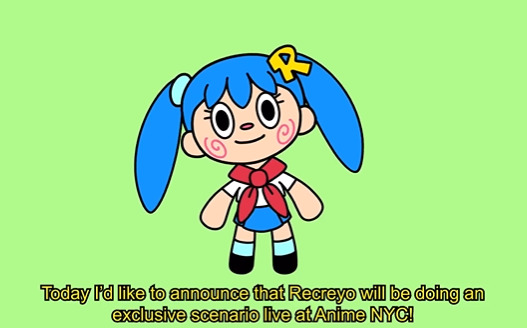
From this video alone, RC definitely appears more like a mascot than anything- a one-off character who would only be mentioned for two visual gags from then on, plus a drawing that Ivan did shortly after the second video.
It's important to note that one of these references were definitely coincidental, and I don't want that to be forgotten. However, I wanted to address it just in case. After all, an accidental reference could very well be spun into a lore tidbit.
( The picture below is from a video's ad I can't remember, so if you find it please lemme know )

The video that that frame is from is old, that much I know. But recently, definitely after that video was up for months, Ivan dropped a possible season 2 design for RC. (3/23/23)
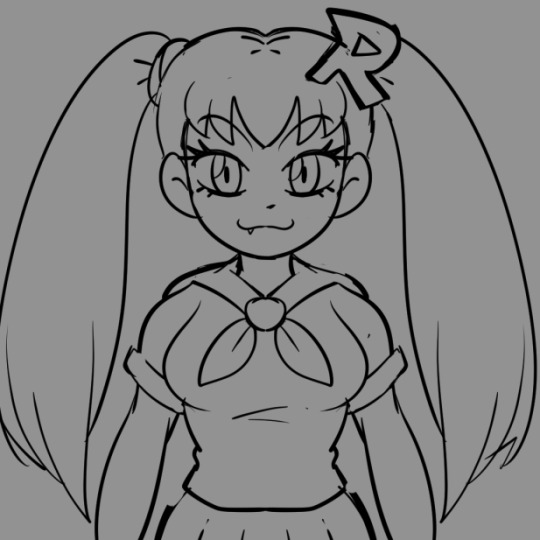
And what do you know, on the 17th, only 6 days before that drawing was sent in the Discord, we saw RC again. Albiet, it was just by name, so we don't know if it was just another gag. It likely is, since the animator could've drawn it ages before we saw it uploaded, but...
Let's just keep it in mind.
( The picture below is from We Let an AI Write This Video )

After these small bits, though, we got two actual appearances from RC. Ones that actually kept her design and so we know for a fact that they are the same character. INTENTIONALLY this time, I should add.
( Picture below is from Can You Survive Dr. Stone? )

At 9:31, Curt says "Nah, I gotta progress the plot." and we see the screen glitch with this frame showing up. This is, without a doubt, RC. From the blue hair, the red tie, and even the spiral cheeks- this is the mark that she was becoming something more.
(Plot-relevant, if you will.)
Being deliberately consistent now, we can take this a little more seriously.
I wanna say that although I don't know the specific time, the video was uploaded at the latest: 2:48 PM. I know this since that was time of the earliest message about the video in the Discord.
You might think it's redundant, but I bring the time up because everyone who was in the Discord would know that something else had happened that day, and it's incredibly important that we're all aware of it.

This person, who I'll call CA, had joined at 4:12. Two whole hours after the video was released, and so a lot of people had already watched it by then and had theorized about RC's surprising return.
Everyone's lore theories were public. And although framed as a hacker, CA was all obviously a plot by Recreyo to get us riled up for the lore. We know this, since Curt himself had showed up in the general chat prior to "play dumb" about everyone's collective breakdown.
Anyway, to summarize what had happened after CA showed up:
Everyone was pinging them, flirting, etc. Basically trolling, but also publicly theorizing that they were RC's account. By the way, "c̶" also was in the video's description, almost matching CA's name.
CA had a role (shown above) that put them at the top of the member-list. They were also apparently unbannable according to the mods.
Curt got "hacked" and if memory serves right, his PFP changed to the glitching RC picture. He sent the message "c̶̓̈a̶͛͛c̶̓̈a̶͛͛c̶̓̈a̶͛͛c̶̓̈a̶͛͛c̶̓̈a̶͛͛c̶̓̈a̶͛͛c̶̓̈a̶͛͛c̶̓̈a̶͛͛c̶̓̈a̶͛͛c̶̓̈a̶͛͛c̶̓̈a̶͛͛c̶̓̈a̶͛͛c̶̓̈a̶͛͛c̶̓̈a̶͛͛c̶̓̈a̶͛͛c̶̓̈a̶͛͛c̶̓̈a̶͛͛c̶̓̈a̶͛͛c̶̓̈a̶͛͛c̶̓̈a̶͛͛c̶̓̈a̶͛͛c̶̓̈a̶͛͛c̶̓̈a̶͛͛c̶̓̈a̶͛͛c̶̓̈a̶͛" into the announcements channel.
Den banned Curt after confirming that he was "hacked."
Curt rejoined and got his Recreyo role back. However... CA is still online as I type this.
Again, everything was obviously a stunt, and I don't need to argue about that. However, I want to take all of this seriously in the sense that it's lore-related, because if we keep on going "it's just a joke" then everything in Recreyo's lore wouldn't matter. So SHUT THE FUCK UP IF YOU'RE TYPING "IT WAS AN APRIL FOOL'S JOKE" (BECAUSE IT WASN'T EVEN APRIL FOOL'S FOR THEM!!!!)
Anyhow, I think it's obvious that CA is connected to RC. Whether they're the same person or not, the glitch theme mixed with the hacker idea is way too similar. And if you're not convinced that it's even a motif, then let's go into today's upload.
( Picture below is from Officially Announcing the New Recreyo Member )
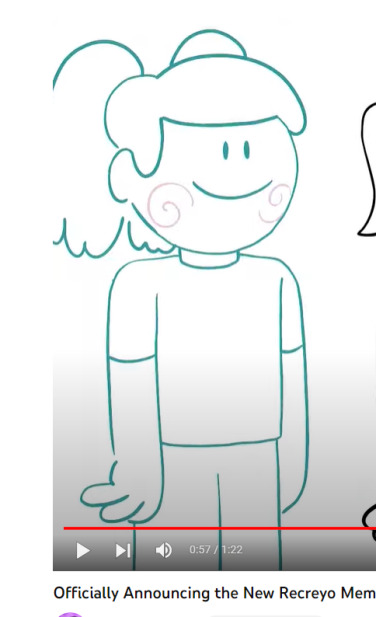
..Yeah, so this is happening. This is real.
An interesting detail is that RC was originally Den before glitching onto the frame. And if you continued watching, you'd notice that the screen pans over and Den shows up on the other side of the picture.
So... this is where we end with our sudden appearances, and we actually begin diving into what RC could be doing here, and what her place in the lore will be.
Let's run down the thoughts that I have:
A popular idea right now is that RC is an AI gone rogue. With the theme of glitching, it definitely fits.
As an explanation for her appearances, we can also assume that she hacks into the videos itself, and what we see on screen wasn't actually what was happening. So instead of her just appearing next to Christian like when they were recording, she instead corrupts the video as it "uploads." This is my current idea, since when questioned about the Dr. Stone video, Curt said:

As for her place into the story, there's a few possible ways for her to be integrated with the current SCP arc. Maybe she's an SCP herself, maybe she's the mystery guide...
I personally believe that she's the one who caused the blackout in the sculpture scenario. In my own headcanon, I had stated that RC worked with the SCP foundation and was integrated with all of the technology. I might not fully believe that now, but I still agree with the latter half.
If she's a professional hacker due to her AI abilities, I don't think it's farfetched she'd be messing up the SCP foundation and trying to get Recreyo killed...
But why? What incentive would she have?
...Well, I've had an idea for a while. I've had RC in my own headcanon lore of Recreyo for quite a bit, and I even called the possibility of her being an AI. The malice I believe that she'd hold towards her creators involves the theme of freedom. Being a real person rather than a character. Vengeance.
I definitely doubt that The Bunker Trio would be brought back (as much as it pains me to say) but something I associate a lot with them is how much tragedy they went through.. solely because of Recreyo. Being original characters, all of their pain was directed by Curt and exploited for content, IN-UNIVERSE.
These themes I have with them are something that extends to RC. I believe that RC is intending to take over the Recreyo channel as payback for bringing her into a world just as a mascot. If she was given the blessing of intelligence, then why the hell was she only used as a mascot?
This is getting a little meta, but I want to emphasize how she was only a lifeless one-off character. I honestly believe she only has lore now because Recreyo realized how obsessed with it we are. So they dig up an old character who hasn't been touched in two years, and suddenly she's the star of the show?
RC is sick of being used as an "idol." She'll let her face haunt the videos for now, but she's going to take over one way or another.
....Or something like that. I can't tell if this even makes sense, but that's basically what I think about RC. I have other headcanons, like how I think she and Roberto work together as a duo, but those are far from what's actually happening.
But then again, I only have these stupid headcanons because I hadn't counted on her becoming a character again. I thought that she was honestly retired.
I might've originally dug a path far from the road of canon, but if it means Recreyo is finally exploring their potential of storytelling, then hell- you already know that I'll be running back.
(Also while I was typing this, CA changed their name to CAN. So.. yeah.)
52 notes
·
View notes
Text
Produce High Traffic on your Site
Make High traffic to your site? The going with traffic-driving approach are normal in nature. You won't have to pay a singular dollar for traffic that falls under this bucket. Coincidentally, you should trade your time. Plus, since time is a more serious need than money, in that it Digital Marketing Company in Canada must be used once then it's gone everlastingly, there's starting in the no so distant past a critical cost included depending on your health level.
Typical Methods of reasoning
#1 - Recognize Phenomenal Website page improvement (Web sythesis update)
Today, if you don't fathom Web overhaul, you're doing yourself an affront. Discover the nuances of Web streamlining with the objective that you're taking an interest in the right sort of traffic improvement structures. You would lean toward not to turn or upset the rules. Likewise, by genuinely having a cognizance of Site improvement, you could really supercharge your results. Find an okay course or book recording about Web update and learn like the breeze.
#2 - Make Unquenchable Substance
Quality framed substance is the last fundamental factor. For whatever time period that you make unquenchable substance on your website page or blog, you'll keep the visitors returning for to a dependably broadening degree. In addition, the better your substance is, the more associated with your visitors will be. They will share your substance for you, helping with inciting your site on autopilot.
#3 - Answer Requests on Quora
Quora is a brilliant mode for overseeing individuals to your site. Answer requests on this stage and alliance the right catchphrases to remain content on your site page or blog. In any case, don't use this phase to spam. Affirmation that your answers are direct and that you hear what you're communicating
#4 - Make YouTube Video Instructional activities
YouTube is an amazing resource for driving free typical traffic to your site. Perhaps this is thinking about the manner in which that Google loves YouTube, and contemplating that it's the second most noticeable web crawler on earth, getting introduction on YouTube could be enormous. Make obliging instructional activities and records that unite a huge degree of fundamental worth and make a point to relationship with your substance through the depiction.
#5 - Get Social On Instagram
Everyone fathoms that Instagram is a wildly noticeable stage for sharing photos and unite with others from around the world. Regardless, barely any people perceive how to utilize Instagram to guide individuals to their site. Regardless, various people have gathered multi-million dollar affiliations just by using Instagram as their essential framework for driving traffic.
#6 - Impact LinkedIn's Passing in front of an audience
LinkedIn's passing on sort out is a striking system for indicating the substance that is starting at now on your site. Appropriate a novel, five star post on LinkedIn that passes on an enormous degree of epic worth and affirmation that you interface that substance to remain content on your blog or site page to get that fabulously essential force stage to your principal post.
#7 - Post On Medium.com
Medium is one of my go-to stages for moving my substance and gives another authority-page space that gives you the adaptability of alliance dropping the way by which that you for the most part would through any blog region on a CMS like WordPress. Impact Medium to make trademark substance propelling posts that in like manner accomplice back to your significant posts on your site or blog.
#8 - Use Email Showing
Email demonstrating is an extraordinary technique to guide individuals to your site page or your blog and to move any offers, at any rate it in like manner concludes that you need a snappy outline to market to. Make a lead magnet and manufacture a business pipe quickly in case you haven't actually starting late done in like manner, in order to build up a once-over that you can at last communicate (not spam) any of your courses of action to.
#9 - Update "Completed" Content On Your Site
Recorded animates of substance is something to be appreciative for, especially if a piece of your substance has sneaked past. Note, this doesn't mean re-doing your substance; basically resuscitating it to get it current the occasion that it isn't starting at now evergreen substance. Look at ways you can revive out of date substance on your website to drive more traffic through noticeable quality on web crawlers like Google.
#10 - Make A Free Online Course
Making a free course is a phenomenal system to control individuals to your site. You can use Udemy, Open to bearing or any number of objectives out there all together. Confirmation the course passes on an immense degree of essential worth and a brief time period later pushes and affiliations understudies to additional substance and offers on your site.
#11 - Make And Offer First rate Infographics
Building unbelievable infographics are only a solitary kind of deceiving substance. There are heaps of deluding substance models that you can utilize, yet very few out of each odd one of them are made proportionate. Notwithstanding, in case you can fabricate an astonishing infographic that various people will interface with, you can in a general sense make a modernized driving machine for your site. Attestation you utilize a stunning organizer to do this.
#12 - Assemble Industry-Express Surveys
I'm continually interfacing with industry-express evaluations through substance on my blog. This is a phenomenal system to draw in tremendous amounts of relationship by passing on something of basic worth. Affirmation that it's specific to your claim to fame and fundamental to the substance on your webpage page or blog and a brief time span later offer that review with the world.
#13 - Focus On Versatile Usability
Real about driving traffic? By then you need to ensure that your site is insignificant neighborly. Use Google's Page Bits of information Instrument to check the genuineness of your versatile arrangement and check whether it consents to rules. You should in like manner guarantee that the aggregate of your posts and substance are AMP-detail planned.
#14 - Recognize CDNs And Program Saving Instruments
Content-Transport Frameworks are a surprising technique for vitalizing page advancement over the world. Google and other web crawlers are unavoidably stressed over the speed of your page and page content. Use Amazon's AWS, MaxCDN or any number of various devices out there to utilize CDNs close to program holding gadgets like W3 Full scale Store, WP Super Store, and others.
#15 - Make Free Online classes
Free online classes offer an astonishing stage for guiding individuals to your webpage. You can modernize your business presentation with online course organizes like Demio, GoToWebinar, and others that exist out there. Use a chance to give regard while similarly directing watchers to your site and its substance near to any offers.
#16 - Post Consistent Substance On Reddit
Another amazing methodology to guide individuals to your site is to use Reddit. Reddit is a wildly standard stage where you can share vital information and take an interest in conversations with unlimited people from over the planet. The zone is exceptionally standard, making any relationship from the site obliging for boosting your perceivable quality over the web.
#17 - Make SlideShare Presentations
You can use a phase like SlideShare to pass on shocking PowerPoint presentations that are Google-obliging, finally turning into your discernable quality. If you do it right, and your presentations change into a web sensation, which they appropriately can on this stage, and that partner interfaces with your site page, you will drive a tremendous measure of traffic boundlessly.
Paid Traffic Methodologies
Plainly, paying for sees and various exercises is constantly one technique to guide individuals to your site or blog. If you have a touch of spending plan, and you track things sensibly, you can think about a cost for each securing (CPA). If your CPA is acceptably high, you can carefully scale your pushing pay. Try to execute things like Facebook and Google following pixels to pick the adequacy of your observes.
#18 - Use Outbrain or Taboola To Push Your Substance
Districts like Outbrain and Taboola are uncommon for moving your webpage page or blog as long as you have a couple of approaches pipe strategy and an ability to follow those individuals who appear from these stages. These regions will move your substance over endless other in every practical sense vague districts over the web for a charge. Notwithstanding, try to do your due unfaltering quality and test things out before making a hop wildly.
#19 - Purchase Advancements Through Facebook
Need access to the general swarmed? Obviously, you can reveal on a phase like Facebook. For whatever time length that your offer is sufficient connecting with, and you can change over that traffic into manages an exceptional courses of action page or free offer, by then you can scale this raising advancement out endlessly to drive in every practical sense boundless approaches.
#20 - Impact Google Re-Concentrating on Observes
Google re-concentrating on observes are a staggering procedure to get more traffic to your site. In any case, a fantastic traffic. Re-concentrating on headways pivot around people who've starting late visited your site and have kept separate from the blue without completing a game-plan. This merges the utilization of a change pixel for purchases and it's an extraordinary methodology to contact people who've starting late been to your page and compellingly market to them on Google's web record not long after they've left.
1 note
·
View note
Text
Intro: Transcript
Episode Show Notes
[This can also be found on AO3!]
O: Welcome to the AfterSpark Podcast, an episode by episode recap of the original G1 Transformers cartoon. I’m Owls!
S: And I’m Specs!
O: And we’re here to talk to you about giant robots. Or at least, we will be! This is actually our intro. What we’d like to do is recap all of generation 1 because it is full of glorious, glorious cheese. Delightful, cheesy goodness and honestly we just want to talk about it, because it’s fun.
S: Yeah
O: And we just wanted to introduce ourselves and kind of our experience with fandom and what things we like before we got into actually talking about the episodes. You should be able to check out our actual first episode the same time we post this. So if you’re like, “Hey, I don’t really care about any of this stuff,” it’s cool, I get it. The other episode’s over there. It’s fine, we’ll see you in a few minutes. For the rest of you that are sticking around, allow us to introduce ourselves. We’ve been friends for nine (9) years.
S: Mm-hmm.
O: Uhh, we went to college together. We were both in art degrees so we like art and comics and media and all that junk.
S: Yep, yep.
O: We’re also neighbors that live in the same building, so one day I was like, “Hey, hey, Specs, want to talk about giant robots?”
S: And I’m like, “Yes!”
O: So here we are, getting ready to talk to you about giant robots, hopefully. We are both first time podcasters, and a shoutout to my husband Chezni for helping us out with sound, so hopefully we don’t sound like complete shit while you’re listening to us. Hopefully it’s a little bit slightly, well, cultured shit -
S: [Laughter]
O: -Or at least our sound quality doesn’t sound awful, because that’s a big deal in podcasting. One of my biggest inspirations was the Jem Jam, which is another podcast that does episode by episode recaps of Jem and the Holograms, which is another Eighties (80’s) Hasbro-
S: -Franchise.
O: Thank you. That is equally ridiculous in vastly different ways. Mostly involving the Eighties (80’s) and music and hair and fashion and all these lovely things.
S: And Soap Opera Drama~!
O: And Soap Opera level of drama. It was also delightful. Go was the show or listen to the podcast because it is completely ridiculous and highly entertaining. But! Something I noticed when I was trying to kind of look around at Transformers podcasts was that I didn’t see anything that quite had that same vibe of just a bunch of friends talking about something ridiculous and I really wanted that and realized it wasn't there and thought, “Eh, maybe we can do that?”
O: And yeah, that’s what we’re trying to do.
S: So. Hi, I’m Specs. I’m been, uhm. Oh, this feels- [sigh] - This feels like I’m in a support group.
O: [Laughter] Welcome! Tell us how Transformers has affected your life. Tell us, Specs! Tell us!
S: Eh, I got into Transformers in like 2002-2003 and I got into it with fanfic. Because of course I did. So much fanfic over the last, like, sixteen (16) years. Oh my god. [huff of laughter]
O: She has quite a collection downloaded.
S: I save things. Habitually. After, uh, there was the great ezboard wipeout of, like, 2005. So, I got into fanfic. Or got into Transformers through fanfic basically I’d been poking through the Medabots thing [category] on fanfiction.net and oh. This person who wrote this thing that I read has also written about these other robots. And I was like, “Ok, let me check this out,” and I had no idea what was going on, so I was like, “I’m going to read through this entire category or at least look through, find whatever the heck looks interesting and then read it,” and that was like 4000 things [fics/works] in the category at that point.
O: Which is significantly less than what’s in there now, I do feel the need to point out. But!
S: I still went through that, and yeah there was a lot of stuff. Yeah, there’s actually still things I really like that I read way back when but basically that was my first exposure to transformers. My first complete canon experience was the G1 [Marvel] comics, but US and UK runs. So I’ve read the entirety of that and I think I read that before 2003 was done, so before 2004. I’ve still got it. It’s been a long time since I’ve read it. Basically, my dad bought a CD, two CD’s actually that had scan of the comics and that’s how I read it and that’s my complete G1 comic experience.
O: So accidentally pirating. [Laughter]
S: [Laughter] Kind of, yeah.
O: Not intentional, but, uh, y’know.
S: Yeah, and then I ended up on the Padded Cell, which was like the- the major sort of transformative fandom hub at the time? A lot of the stuff you see in fanfic now came from people who were on that forum from like 2000-2008. It wasn’t really the hub of anything anymore as things shifted to Lifejournal and [later] Tumblr, People moved away from forums and into, y’know-
O: Other social media accounts.
S: Yeah
O: That were easier and, y’know, they didn’t have to keep servers up and all that junk.
S: Yeah, but it was- it was neat, because I got to see a lot of the fandom stuff, like evolving firsthand, but, uh, so yeah. My fave G1 characters are Ratchet, because I really thought that he was the main character-
O: [Stifled laughter]
S: - in the comics for awhile, because, like, everyone is frigging, like all the Autobots are frigging out.[Laughter] LIke really quickly after they wake up and Ratchet’s just off doing whatever with Buster and then he has to do like a blood-fuel? Pact with Megatron-
O: [Laughing]
S: [Laughing] -and it’s weird. Yeah.
O: I have no frame of reference for any of this.
S: Well, maybe you will soon.
O: She’s lending them to me. Oh no.
S: And then there’s Dead End because like the first DVD’s that I got- I got the second half of season two, and was like, “I like lIke Dead End’s voice, oh no, he’s depressed. Let me hug this- hug this poor robot and so I got the entire. I have an entire, like, complete original G1 Stunticon toys. Set of the G1 toys with all of their combiner stuff. Never actually got around to combining them because I’m lazy and I was more interested in the characters themselves than in Menasor. So yeah, I’ve got those and I’ll bring them up to show them to you and I’ll bring the Alternator Dead End up, too
O: Yes, show me more toys!
S: And- And Wheeljack., which I don’t have an original Wheeljack toy, but I do have a Wheeljack Alternator. Basically G1 sort of got me on the kick for medics and scientists. I like most of the medics that pop up in various series. And yeah, so, favorite overall character is Ratchet and Rescue Bot Blades, who is coincidentally, the Rescue Bots medic. [Laughter]
O: He was before he got turned into a helicopter [laughter]
S: Yeah
O: Which is a great out of context thing to say.
S: Yes, it is.
O: Blade’s is adorable!
S: Like all of the Rescue Bots characters are adorable and you should watch that right now. Go watch it.
O: It is better than it has any right to be. I know, you’re sitting here going- if you haven’t seen it already- why would I watch something that was made for preschoolers? It is written better than it has any right to be. I do not know why, I don’t care why. It is actually quite good and very entertaining even if you’re an adult and you like transformers.
S: It’s got some of the most consistent writing out of any of the shows, like they knew what they had to do, they worked well within the guidelines they had to work with. Like, no one can die, no one can be seriously injured.
O: Right. Because preschoolers. Right.
S: And so it doesn’t have any of the weird tonal inconsistencies that sometimes Prime could get and it wasn’t, like, canceled like Animated was.
O: [softly] Yeah.
S: [sighs] And then Rewind. He’s basically kind of a librarian, and I think. Just Rewind and Chromedome are really neat. I like them both. I like most of the IDW characters.
O: They’re very, very good.
S: Mm-hmm. Favorite series: IDW G1, especially phase two. My favorites are Lost Light and More Than Meets The Eye. I still have a really soft spot for the original G1 comics, cuz they’re the first things that I read.
O: That makes sense.
S: Mm-hmm. And so, let’s - let’s go over to Owls.
O: Hi! My name is Owls. Uh, so in contrast to my friend, I’ve been in the fandom for three months, maybe. It all started a fateful day when I watched someone on YouTube talk about Beast Wars. I had the sneaking suspicion of I vaguely liked Beast Machine’s growing up? Didn’t remember anything else and thought, “Hey! I should watch Beast Wars!” This was my first mistake. At which point I, ah, messaged Specs and I was like, “Hey! You’ve got a copy of Beast Wars, right?”
S: Yep, mm-hmm.
O: And she did, and I watched it and then I rapidly ascended into Transformers madness. And I now lie at the bottom of a ravine getting buried by toys, comics, and various amounts of DVD’s.
S: Yep. Ones [Comics and DVD’s] that I’ve mostly lent you, but… [Laughter]
O: Mostly. I did buy Beast Machines, because she didn’t have it and I wanted to watch it and I have Opinions™. I have Opinions that I won’t get into right now. But I have opinions.
S: You also have Beast Wars.
O: I also bought Beast Wars, but that’s because it is my favorite Transformers thing. SO I’ve probably watched about six different animated series, uh, and the Bay movies and now I know enough to hate the Bay movies. Oh my god! I didn’t know before but now I do. [Laughter] Now I do.
S: Now you know the pain.
O: Now I do, yes. My desk is rapidly accumulating Transformers. Help.
S: [Laughter]
O: We’ve got Grumpy Desk Raptor, and we’ve got 99.9% Done-With-Your-Shit-Rodimus-Grandpa, and smaller, more murderous Desk Raptor. I’ll leave it you to figure out who those three are. [Laughter]
S: I like your desk raptors-
O: My desk-
S: and grumpy grandpa.
O: I-I-I collect grumpy, grumpy characters. This is going to become a theme. Ah, my favorite characters are Dinobot from Beast Wars, who is AWESOME! And I’m so mad he doesn’t show up in anything else! But I guess I should be happy he’s alive in the IDW comics and presumably in a good place?!
S: He’s in the Christmas ep- He’s in the Christmas episode, basically.
O: There’s an adorable panel, it is my life. Ahem. Anyway, so Dinobot from Beast Wars, Lost Light Megatron, which, if you’ve not read the comics, I won’t tell you we’re going to be spoiler free here, but I also don’t want to like be blatant about it so, he’s really well written and I really enjoy him and there’s a very, very obvious reason for that if you’ve read the comics. I also really like Transformers Prime Ratchet, who is just a serious Mood. Uh, he, y’know, is trying to do his job and then he’s like “What the hell are all these human children doing here? And you’re breaking my shit,” And honestly, that’s kind of how I feel most days if I’m around children, yeah.
S: And then he takes over their science projects, because of course he does.
O: Transformers Prime, though I love it, has some weird tonal issues.
S: It does.
O: We’ll get to that eventually.
S: [Softly] It does.
O: I-I feel like I have to do some honorable mentions for pretty much any version of Soundwave, Grimlock, and Starscream in existence. Except for Grimlock from Car Robots or the 2001 Robots in Disguise, because he doesn’t really act like Grimlock. Regardless, they’re all delightful and I love them. And that basically sums up the characters I like for G1 pretty well, which is Soundwave and Grimlock are probably my favorites. Uh, I also rather enjoy Perceptor and I enjoy Megatron for the pure, pure delightful camp factor. [Laughter] He has no redeeming qualities and I love him.
Both: [Laughter]
O: None. So obviously, I have been here for, oh, three months. I know nothing about fandom. I really wanted to do something to get involved, and was like, “Oh dear gog, I can’t draw robots, I don’t really think I feel competent enough to post fanfic,” and I thought, ‘By god , my executive function must surely be worth something.’ And then I decided to put together a podcast, because through the powers of organization, anything is possible.
S: It is, it is. [laughter]
O: And here we are. Through the power of organization. That being said, ah, with us doing this podcast we really wanted to try to put some emphasis on fanworks and fanart and so what we would like to do with the episodes we release is recommend a fanfic and maybe some fanart with our episodes because Specs has been in the fandom for so long she;s got this great stash of ~vintage~ transformers work. Not all of it we can share because some of it’s been taken down and we don’t want to post something without the original authors’ permission or it being posted somewhere, but basically we’re hoping we can give you some good fanfics to kinda go with the theme of the episode . So, should be fun. That being said, if you’re got recommendations for fanart or fanworks-
S: Or questions, or complaints. I’m our complaints department for the record.
O: You can shoot us a message. You can find us on Tumblr. We are AfterSpark-Podcast on Tumblr and you can find other methods in which to contact us there. All that being said, I think we’ve kind of come to the end of our intro here. Hopefully you’ll come join us on our delight ride
through generation 1 and the waves of pure cheesiness we are about to embark on, because trust me, we are.
S: Our delightful ride on jousting jets.
O: A delightful ride on jousting jets. Just wait for it. Um, well, this is Owls!
S: And Specs!
O: Signing off. Thanks for listening to AfterSpark Podcast.
S: Toodles!
1 note
·
View note
Text
The Master (2012) | Written and Directed by Paul Thomas Anderson
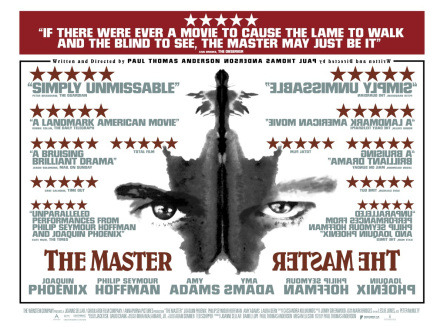
youtube
Intro and Technical Details
I try to figure out why I gravitate to certain films. Most of the time, it’s after someone asks me what my favorites are. I tell them, and then 90% of the time they don’t understand why I like those particular films. I’ve asked myself if it’s just some kind of wanna-be elitist, cinephile phoniness or something...but that’s not it. The reason I love films like The Master is due to their elusiveness. The Master shows you an approximate direction, but doesn’t overtly tell you what the answer is. In my eyes, this places it in a special category of cinema which is mysterious and often transcendent. It has something profound to say about us as humans and morphs with each viewing. It is alive because it doesn’t spoon-feed you an agenda or proposed concrete “truth” or “moral lesson”. My goal in this post is to take what I know and implement my personal thoughts and film knowledge to try to gain a better understanding of what this film is. This is my third post analyzing a film of my choosing. The first was about two women (Persona), the second was about a man and a woman (Cold War) and The Master is about two men. When people ask me what my favorite movie is, I tell them The Master by Paul Thomas Anderson. This is also PTA’s favorite film of his own. I remember the first time I watched it was at the NoHo Laemlle Theater a couple of blocks from where I live, right off of Magnolia, which happens to be the title of the first Paul Thomas Anderson film I ever watched. But while watching The Master that day in the theater, I remember feeling lost and dumb. I knew A LOT was happening but I didn’t know what. It left me behind. As a short filmmaker, when I first started (around the time The Master came out) I would just have stuff in my films (images, sounds, lines, etc) that were superfluous and didn’t have any legitimate reason for existing. My intentions were good...I was trying to create an atmosphere, even though a lot of the attempted atmosphere didn’t connect to the story or the idea being examined. I think it’s because a lot of the movies I was watching during that time I didn’t understand. I didn’t know why the director was making the detailed choices he or she was making. I still don’t always know the reason, but I do have a better idea. I must’ve thought these choices were just there spontaneously or by accident...for style-sake maybe! I was just going along the ride without consciously considering the nuanced decisions the director or actors were making. And oddly enough, this particular film is about a cult called “The Cause” and every cult’s main philosophy-based objective (in some odd form or fashion) seems to be to awaken your consciousness to yourself and/or to reality. If one is a film lover, and is so inclined to dig into this film, I believe one must watch consciously to understand it and not just go on the ride. And at first glance, one might make the mistake of thinking there is no rhyme or reason for certain moments, but Anderson is a filmmaker that does a vast amount of research and is very aware of what he’s packing in there. A literary example (which is much more elusive) is Finnegan’s Wake by James Joyce. Many believe Joyce was just goofing around with words, but if you read Joseph Campbell’s Skeleton Key or do some independent research on each phrase and term (if you have 10 years), one will realize there is meaning within the puns and riddles and melding-words. Finnegan’s Wake is a circular book and I believe The Master is a circular film. Finnegan begins again and I believe Freddie begins again. Roger Ebert gave the film 2.5 out of 4 stars and I love the first two sentences of his review: “Paul Thomas Anderson’s "The Master" is fabulously well-acted and crafted, but when I reach for it, my hand closes on air. It has rich material and isn't clear what it thinks about it.” Of course, I disagree mostly. I agree that the material is rich, but I think it’s clear what it thinks about itself more than Ebert thinks...and I’ll elaborate on this opinion throughout this detailed post. The next sentence in the review (after the quote above) is about how the Dodd character is based on L. Ron Hubbard, the founder of Scientology, but how in the film there is no clear vision of what the cult is or what it becomes. I believe we see quite a bit of what it is and we see that it has expanded to England by the end of the film. The film never lays out the exact tenets of the cult in list form, but Dodd himself is making it up as he goes along and this is expressed multiple times in the film. I also believe enough is revealed to get a fairly good idea of the cult’s philosophy and the methods being used for “curing”. Also, in my opinion, I don’t think understanding “The Cause” is entirely relevant to what the film is trying to say. The film is mainly about the symbiotic relationship of the two main characters, Freddie and Lancaster. I rewatched There Will be Blood last night (Anderson’s film before The Master) and the thought came to me that you have to watch the expressions of the characters closely during these films and follow what’s happening inside of them. This seems so obvious to point out, and could definitely apply to any film-watching experience, but the acting in Anderson’s films is so strong and subtle one will be lost unless you watch the silent moments and what the faces show you. I'm really trying to pick the right words to express this...but you have to consciously tell yourself while watching (in your thoughts) what’s happening with these complex characters if you want to understand the transitions. I don’t think the camera movements are as important in The Master nor the lighting, but it’s the characters’ internal life expressed in their faces manifesting from their psychological states, needs and wants. Of course, Freddie’s gait is a big part of his character and various body language from the all the characters are important, but their faces tell you most of the story. Also, I believe some knowledge of Spiritualism is needed to bring to the table, but I don’t think it’s absolutely necessary to understand what the film is trying to say. But anyway, perhaps I’m over-explaining too soon. I was trying to figure out how movies like this get away from people (including me) and cause so much confusion. The last time I saw the film was about 6 months ago at The Egyptian Theatre in Hollywood where the premiere was in 2012. The screening I saw may have been the same 70mm print from the premiere, but I could be wrong. I just tend to think there’s not too many 70mm copies out there. The Master was the first fiction film in 16 years to be shot in 65mm and then 5mm is added for the audio track. I didn’t know for a long time the reason why such a big film stock made a difference, but apparently it’s because more information can fit on each frame, therefore it’s crisper and more details can be seen...which makes it epic and ambitious and a filmmaker is really swinging for the fences if they use this big stock! Anyway, there was quite a large crowd at the Egyptian and I remember laughing at a few spots where no one else was and kinda had to pull myself back. I also remember noticing a lot of things I hadn’t noticed before and I’m sure this will be the case when I rewatch it again for this post. Before getting into the film, I'd also like to mention I will probably come off as a bit of a fan boy in this excerpt. It is because I believe Paul Thomas Anderson is one of the best filmmakers in the world of the past 25 years and has much to teach in a field that I’m passionate about. Also, I believe The Master is a master-piece and there are new interpretations of depth and reference that I am still uncovering (or think I’m uncovering).
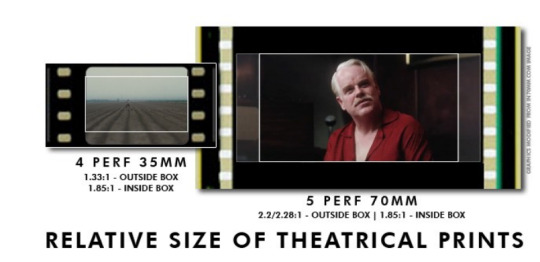
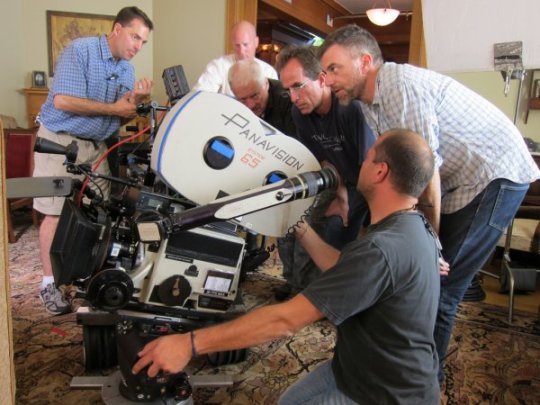
Freddie Quell, Navy Man at Sea
The opening shot is of aqua blue water behind the back of a ship, which is also the dominant color in the palette of the film and the color I think of when I think about the film. Johnny Greenwood’s score crashes in and then we see the first shot of Freddie Quell in a bunker with a military helmet on. I can’t remember where I read it but Paul Thomas Anderson told Joaquin Phoenix to mimic the monkey in the hot spring from the documentary Baraka for this shot, which also coincidentally was filmed in 65mm. I’m sure it's partly a nod to the film’s use of the same stock size, but I also think it's covertly setting us up for Freddie’s animal-like nature...or pointing to the animal-like nature of war and how this particular primate, Freddie, is expected to change his entire behavior, which is attempted by Lancaster Dodd throughout the film. Simplistically put, Freddie indulges in his animal nature. Dodd denies it. A dichotomy that will also act as a magnet between the two throughout the film and something that I will point out several times. Also, we wonder if war broke Freddie or was Freddie already broken? Or is he actually “broken” at all??


We immediately see that Freddie drinks heavily and how he is markedly different from the other soldiers in the group. He takes things too far and is much cruder than the others. He drunkenly simulates sex with the nude sand woman the guys have made and then masterbates into the ocean. He then lays down and closes his eyes next to the sand sculpture bosom, almost oedipal-like, sweetly spooning its side. This exact same image will pop up again and I believe it holds a large significance in the key to understanding the film.
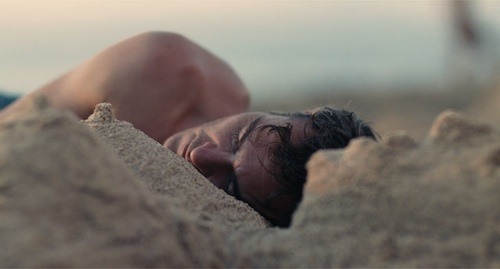
It is next revealed Freddie can make booze out of pretty much anything as he drains what looks to be the ship’s missile fuel into a cup. This also seems to be Freddie’s way of making friends with the other troops, as it is simultaneously announced that World War II is over. The camera scans the room and shows all the interesting yet shell-shocked faces of the troops as it’s explained to them by their superior they are now able to enter the world. They are told they can now open up their own businesses with the skills they’ve acquired. This doesn’t come off so much as anti-war, but obviously points out that a lot of these men are damaged psychologically, and the military either comes off as naive or willfully ignorant regarding the mental state of the guys entering the world post-service. This is magnified by a comical scene of Freddie sitting in a room with a hardened military psychologist who shows him rorschach blots as Freddie interprets every single one as extremely sexual. Phoenix is amazing in these closeups and the camera is able to hold on him for long periods of time. This was after his fake retirement from acting and I think he was hungry for this film. His face is gnarled with lines. He has this mumble that’s slightly distracting but makes you lean in as he moves in and out of the camera’s shallow depth of focus. This film has so many closeups and doesn’t include the long steadi-cam and dolly shots like in Boogie Nights or There Will be Blood. The comical scene is followed by a sad scene showing us that Freddie has some real psychological pain. He talks little and very uncomfortably to another military psychologist about his family and an old sweetheart. Freddie mumbles, “you can’t help me” and later sarcastically says, “thanks for the help”. Later on we wonder if Dodd gives him real help opposed to these psychologists.

Freddie Enters the World
Freddie has a job as a photographer in a department store. The portraits look lovely. The song underneath during this scene is perfect (”Get thee Behind Me, Satan” by Ella Fitzgerald).
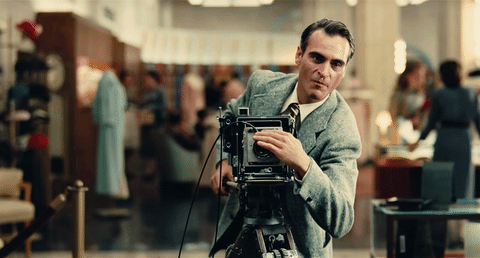


Freddie flirts with a woman that models clothes for customers. He later then mixes some of his potion in a photo-chemical room like an Alchemist. They both drink from the flask and then kiss. She shows him her breasts. Freddie asks her to go out that night, which cuts to Freddie passed out drunk at the restaurant table and the woman annoyed.
The next day Freddie is hung over at work and gets into a fight with a large male photo client. Freddie comically runs from the man and throws various items at him while dodging and weaving behind columns. The camera covers the commotion in wide shot in the department store so well! Then Freddie does something peculiar and funny by grabbing the hand of the model (his date from the night before) like he’s leaving the job and she’s coming with him. She looks at him baffled as they hurry out. Music comes in perfectly here (once again) with a jagged discontinuity of woodwinds which takes us to Freddie now working in a lettuce field in Salinas, California. The shift to this new, vastly different environment is dreamlike. Freddie continues to make booze and gives some to an older man that Freddie says looks like his father. The man gets ungodly drunk and Freddie is run out of the work group after being accused of poisoning the man, which leads to one of my favorite shots of the film. It is a long tracking shot of Freddie running through a foggy field away from the workers chasing him. I liked it so much I tried to slightly copy it while shooting a silly annual family short film in a cotton field in Texas, also running away from farmers. And worth mentioning (assuming my short film is worth mentioning), I remember reading somewhere that Paul Thomas Anderson read about the life of John Steinbeck (from Salinas, CA) and incorporated some of the stories in The Master.
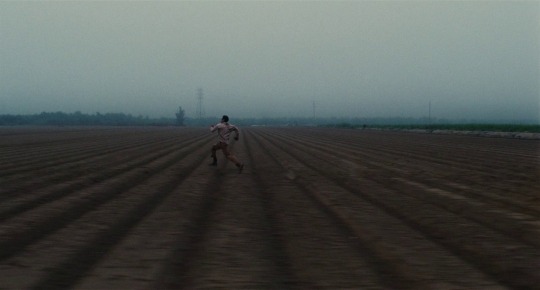
The Master (2012) Paul Thomas Anderson (Panavision 65mm)

The Jackel (2016) Cory Aycock (Canon 7D Crop Sensor)
Freddie Meets “The Cause”
Next, it cuts directly to Freddie walking on a dock, looking cold and dejected. In the distance is a boat docked with a lively party and warm lighting. Music plays and we get our first glimpse of Lancaster Dodd. He dances charismatically with his wife in the middle of an admiring group as Freddie, the misfit loner, decides to sneak onto the boat. The boat is then shown setting out to sea, which looks to be departing from San Francisco under the Bay Bridge.
The next morning, Freddie is hungover and has a humorous conversation with Lancaster, the leader of “The Cause”. Such a great opening scene with these two and Phillip Seymour Hoffman is so great in this role. I think it’s his best performance...but I’m biased. As mentioned, the conversation is humorous, but not funny-haha. Again, I will try to explain as best I can what I feel when watching some of these scenes... They talk in such a way, not necessarily about funny stuff, but they are such characters and there’s such chemistry it puts a smile on your face. You see the inner-game they are both playing and it’s delightful to watch. They are opposites, which creates this lively synthesis and makes you laugh sometimes, but also gives you such a large mindscape to enter during these rich, concentrated dialogue sessions. In this first conversation, Lancaster and Freddie both mention that the other seems familiar, which comes back later. Their association is sweet yet ridiculous at times. A likable naivety exists, but also a sense of intrigue and darkness lies underneath. Dodd tells Freddie, “I am a writer, a doctor, a nuclear physicist, a theoretical philosopher...but above all I am a man...A hopelessly inquisitive man, just like you.” And shortly after calls Freddie a scoundrel, but asks him to make more of his secret booze. A young Rami Malek, Clark, pops up next in the film and is marrying Lancaster’s daughter, Elizabeth. The first interaction we see between Hoffman and Malek feels like a Tom Cruise-like stareoff. Malek stares until Hoffman ducks his head in slight awkwardness. This trivial detail always catches my attention and I’m not sure why. Lancaster gives a speech after the ceremony in triangular blocking. This is my favorite speech of Dodd’s in the film. He is at his most charismatic and funny here, in my opinion, and touches on some of the philosophies of “The Cause” in symbolic terms. He talks about lassoing a dragon and then teaching it stay, then roll over and play dead. I’m almost positive this serves as a metaphor for taming the ego and/or reactionary mind, then learning how to navigate life playfully following this “enlightenment”. Freddie shifts in his drunkeness from confusion to laughter while continuing to compulsively drink all the alcohol in sight counter to the simultaneous speech.
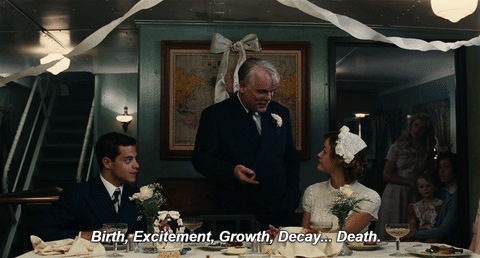
Although, Lancaster loves Freddie’s booze and, again, secretly asks for some after the speech. Freddie’s process of procuring this solution is somewhat like a mad alchemist and shown multiple times in the film. To me, this could metaphorically point to some type of alchemy forming between the two opposite characters considering the psychological and metaphysical tone of the film. It is also revealed the next morning by Amy Adams’ character, Peggy (Dodd’s wife), that Freddie inspires something in Dodd and he has been writing much more since Freddie showed up. Peggy has asked Freddie to sit with her at breakfast, possibly to see what it is about him that could possibly spark this insight in her husband. Despite this, I don’t think Peggy sees anything special in Freddie and doesn’t understand their relationship for the remainder of the film. Actually no one, besides maybe Elizabeth, sees anything worthy in Freddie at all other than Dodd. I believe this is because Freddie fills a unique gap within Dodd. I will expand on this more later, but to me it’s obvious Freddie is filling the gap of the id. Freddie is a scoundrel, an open drunk, a philanderer and a wanderer. These are things Dodd isn’t. He forbids himself of being this and Freddie is counter to this persona of Dodd’s, who is a leader, married and always ON. He is relied upon by his followers, always maintaining his status as prophet for the cult...perhaps the superego. Soon it is revealed there are “processing” sessions occurring on the ship, recording “past lives”. Everything is being put on tape of what people are saying during these sessions. Freddie humorously navigates the ship during all of this. At one point he sits at a table and puts on some headphones and it’s Lancaster’s voice deliberately stating, “We are not animals.” “We are not a part of the animal kingdom.” Simultaneously, Freddie looks across the table at a young woman and passes her a dirty sexual note. She goes back to work as Freddie watches her. The sun behind him shines through the window and perfectly peaks behind Freddie’s head. This is what I meant at the beginning of the post...the film is showing you something regarding the ideas it is trying to express. In this moment it’s not necessarily just in the face of the character, but in what Dodd says in the headphones in direct opposition to Freddie’s sexual note and then the sun winking at us from behind. For some reason, it makes me cringe to analyze some of these moments... demystifying and deflating the “magic” of these details.
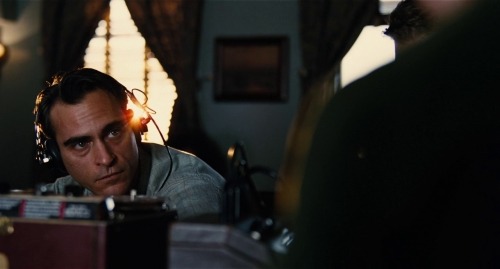
The distinction of “animal” pops up periodically a few more times in the film on the account of Dodd. Again, Freddie (the animal) and Lancaster (the divine) forming a fully whole being. Now, at the 36 minute mark, the best scene between two actors sitting across from each other at a table I’ve ever seen. It reminds me a bit of the scene in Persona where the two women sit across the table from one another when they meld. They also repeat the dialogue here like in Persona and Dodd dresses down Freddie similar to Alma’s dressing down of Elisabet. The face lighting in this scene is also similar, half-lighting the characters but in a dark Charlie Rose-like room directly counter to the white background in Persona. The scene begins by Freddie being processed after a drink with Lancaster. Lancaster asks him probing questions about his life and records it. The scene is funny, dark, raw and nuanced. I can’t say enough about this scene, there is so much here. Phoenix moves and looks around. Hoffman stays still, centered, not breaking eye contact. The first time around, Freddie doesn’t take it seriously and farts in the middle of them talking. Lancaster playfully calls him a “silly animal” and ends the processing session soon after by turning off the recorder. Freddie seems disappointed and wants to do it again. Lancaster sets up the rules this time and tells him he is not allowed to blink during the questioning. Freddie agrees. In somewhat Mesiner-like fashion they continue the exercise in a long closeup on Freddie. Phoenix is amazing here and at one points slaps his face multiple times after he blinks. They start over. Tears roll down his face. Apparently Freddie is severely troubled by his family past and recalls a sexual relationship he had with his Aunt. Then he reveals he was in love with a girl in his hometown named Dorris. It beautifully cuts from the black, heavy room to a bright sunny day and the white house where Dorris lives with colorful flowers in front. This is a beautiful contrasting cut by Anderson transporting us. Also, worth pointing out, is the contrast of how silly the scene started with farts and laughter, then taking us to this this deep, heavy pain within Freddie.
youtube
This is a unifying scene for Freddie and Lancaster. And despite what we think about the legitimacy of the cult, some type of deep psychological progress with Freddie is being made here...a progress that was not even close to being accomplished with the military psychologists. Or is this “progress”? Feels like it. As Freddie comes back from the flashback, it cuts to the aqua blue water again, similar to the opening shot of the film, perhaps personifying Freddie’s current mental state. The color of Freddie’s shirt also matches the color of the water.

Again, there is a charming naivety within Lancaster regarding “The Cause” during his far-fetched final questioning lightening the mood before the two have a drink and smoke a Kool together.
youtube
Funny outtakes at the end of the scene.
Obviously, Dodd is modeled after L. Ron Hubbard, but I don’t think it's a nasty rebuke or hit piece, nor is it an exact replica. I read Anderson and Tom Cruise remained friends after Anderson showed it to him. If one thinks it’s mainly a film about Scientology then they are absolutely wrong. It’s evident Anderson loves these characters in spite of all their flaws and complications. Dodd remains a believer of his own philosophy throughout the film, which I think keeps him likable. You also believe throughout he wants to help Freddie, even though some of that motivation may be ego-based or material for his writing. He is misguided at times but cannot be broadly painted good or bad and does not come off as maliciously pumping out nonsense solely for monetary gain. You believe he believes.
Sea-Legs to Landlocked
The ship now arrives at New York City and the group attends a fancy party at a home. You get the feeling this new spiritual movement is in vogue. Freddie goes straight for the booze and also begins stealing random stuff around the house. Lancaster schmoozes, then is shown performing a processing exercise for a woman laying on the couch for the party crowd. This last time watching, I got the feeling Dodd was curious what she would say and that every session he conducts he secretly sees as an experiment, collecting more data for himself rather than having a fully realized philosophy or completed methodology.
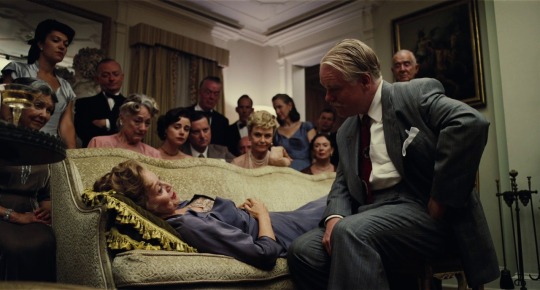
I’ve read Dianetics, so I do believe I have more insight into what’s going on in some of these scenes than a regular viewer. Although, I also believe the information is already there in the scenes if one pays close enough attention. And I’ll say it again, “The Cause” is not a carbon copy of Scientology. But, to generalize, the quest of both seems to be the same...to reach a state of “perfect” (or “clear”) by cutting through past traumatic memories and lifetimes (when the “analytic mind” was unconscious) in order to tame the current reactive mind. After processing, the woman on the couch talks about her past life and Dodd answers some of her questions. Then, a naysayer from the party verbally challenges the legitimacy of Dodd’s claims. "The Cause” is no longer confined to the vacuum chamber that is their boat. Dodd raises his voice in anger and Peggy looks visibly rattled as well. Lancaster eventually loses his cool after the naysayer continues to not back down and calls him a “Pigfuck”, which makes me laugh every time. This is the first time we see Dodd lose his composure in the film. Freddie is observing off to the side and throws a tomato at the guy, probably something Dodd wishes he could do. The party guest is obviously convinced there is no way to have a logical discussion regarding “The Cause” with Dodd and he’s right.
A quick aside and personal story...the actor playing the Party Guest Naysayer is named Christopher Evan Welch. I briefly worked backstage at the Mark Taper Forum in Downtown Los Angeles and Christopher was one of the actors in a play when I was working there. During one of the shows, while waiting for his time to go back on stage, he sat with me for a while and asked me questions about what I wanted to do in the business and where I was from, etc. I was still pretty green. I remembered him being very nice and authentic. This must have been around the time he worked on The Master because it was in early 2012. The next year I found out that he died suddenly of Cancer. Hoffman died not too long after. Very sad. The full scene is below with Welch and Hoffman:
youtube
Dodd and Peggy are upset now in their room after this fiasco. Dodd writes furiously as Peggy speaks, putting words to their anger, completely flabbergasted by this mild rebuke. The whole group is bent out of shape, shaken by this challenge. Freddie, next door, elects to take Rami Malek’s character (Clark) to the naysayer’s room to rough him up and they do (or Freddie does).
The next day Dodd pretends to scold Freddie, but it’s obvious he’s glad he did it. Again, Freddie being the id that is unrestrained and not held down by social convention in direct opposition to Dodd’s persona. This is where something similar comes in comparable to Scientology, because Scientologists are known to go after naysayers, sometimes aggressively. The group nows arrives at a large house in Philadelphia belonging to Laura Dern’s character, Helen. Everyone gets out of the car like a big happy family visiting relatives and you really feel the warmth of their community here. Different courses and talks are being held at the home. Dodd’s daughter, Elizabeth, makes a move on Freddie during one of the talks and Freddie resists. She is a redhead just like his past sweetheart Dorris. In the previous scene, Freddie was ready to go find the naysayer and Clark seemed apprehensive until Elizabeth gave him a look to go. She seems to like Freddie’s aggression. Plus, perhaps, her father’s closeness with Freddie has something to do with this attraction. There are moments when Freddie’s face, with all it’s interesting lines, drifts to another place and the sound completely fades as Anderson holds the shot on Phoenix in closeup. Anderson does tons of planning and research, but you get the feeling on the day during filming he’s constantly looking to catch moments of spontaneity and it seems this choice to hold on Phoenix during this particular moment is a good example.
Freddie continues to get completely wasted alone amongst the others, shown during a party as Lancaster sings and holds court. The scene afterwards always makes me laugh really hard (no pun intended) when Peggy jerks Lancaster off in the sink while making him agree not to drink anymore of Freddie’s booze. She continues to jerk and tells Lancaster if he’s going to cheat on her to not let her or anyone else she knows find out. Lancaster eventually comes and doubles over as he lets out a few violent pleasurable yelps. This is the closest to the animal side we see of Dodd, and this spirited release may point to the pressure build-up. Peggy then walks into the dark room where Freddie is passed out and tells him there will be no more boozing. He reluctantly agrees upon waking. Yet the next scene (the next day) shows Freddie continuing to drink heavily on the sneak. The Philadelphia Police show up at the house suddenly to arrest Dodd for running a medical school without a license. Dodd gives himself up relatively calmly and in contrast Freddie fights wildly with several police who violently wrestle him to the ground and handcuff him. Then there is a wonderful scene following, setting up the two protagonists’ contrast in temperament even more when Freddie is hauled in and put in the cell next to Dodd. Dodd is cooly standing still and calmly leaning on his bunk. Freddie is abruptly being dragged in by four officers, and immediately starts DESTROYING his cell as Dodd just observes. Dodd possibly feels this rage inside but has elected to consciously watch his rage rather than react as Freddie is. Then the two get in a hilarious, childish yelling match after Dodd tries to explain to Freddie why he is how he is. He tells Freddie the cause of his affliction is due to an implant from millions of years ago and that he is asleep (lining up with Scientology). Freddie isn’t having it and says he’s just making it all up as he goes along, echoing what Dodd’s son said to Freddie on the porch right before the police showed. Dodd yells back that no one likes Freddie except for him. Both of the characters have told each other a truth. Dodd then says he’s done with him and begins peeing in his cell toilet. Yet Freddie has no pot to piss in because he’s destroyed his cell, including his toilet. In fact, he may have also destroyed his relationship with Dodd, which would likely mean he will not have a pot to piss in for quite some time.

During a quick arraignment scene with Dodd, the Judge orders him to repay the $11,000 he took and gives him this look that has so much character and makes me smile every time. He cuts his eyes up in this humorously scolding way as he simultaneously hits the gavel. With these great films and directors and actors, you learn that even the smallest scene is packed with so much richness and detail and not wasted!
Dodd is now at the dinner table with his family. Freddie is still in jail. The family open up to Dodd voicing their concerns regarding Freddie. They want him gone. Dodd says they must try and help Freddie get well, perhaps Dodd trying to find a way to keep him around. Now a wide shot outside of the Philadelphia house. Dodd is sitting up on the porch with several others and there is a little girl on a tricycle in the foreground below the steps. Freddie sheepishly approaches the house after being let out of jail like the prodigal son. Dodd cooly embraces him. The little girl runs up the steps into the house. The two men then start wrestling like little boys in the yard, the two halves reconciled, laughing hysterically.

Freddie Quell, Patient of The Cause
Freddie is now being “treated” and/or administered tests in front of about 30 people in the house to “cure” him. Dodd tells him to go from one end of the room to the other, to feel the wood wall and describe it, then walk over to the glass window, feel it and describe it too. He continues this over and over.
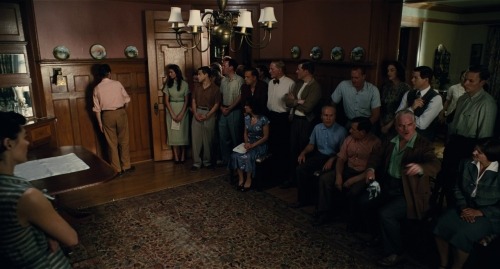
Paul Thomas Anderson is a filmmaker that walks in front of you and you have to catch up. He does this by overloading your mind with scenes that just start and don’t have a lead-up. You have to wait, then you find out. The strength of the music, cinematography and acting lays so much subtext in front of you, it can keep you from following what’s actually happening...which, oddly, I feel is part of what great cinema is. It’s a great distraction...a created atmosphere so thick that one can be swept away by it if they don’t watch out. For example, the first time I watched this film I thought I had an idea what was happening, then I realized I was wrong, but I had already overthought in the wrong direction so far I became completely lost and just sat there asking myself even more wrong questions in my head about what was going on until the credits rolled. I did the same thing in the same theater with Inherent Vice a few years later. In the next scene there is another exercise where Freddie sits across from Clark and is not to react to anything he says, including personal insults. He cannot react in any way (laugh or talk, etc) or Dodd will start over the exercise. This reminds me of the Synanon Cult and their ”Attack Therapy”. The cult used to be located in Santa Monica where the hotel Casa Del Mar is now and I’m sure Anderson had heard of them growing up in LA. Clark immediately says “Dorris” and Freddie breaks right away, looking to Dodd knowing Dodd told Clark to say this. Dodd replies, “Fail” and they have to start over. In my opinion (and I think I’m right) Dodd wants Freddie to get to a point of non-reactivity, possibly closer to a state of “clear”. All the individual’s insecurities are placed in the forefront consciousness (also why they record everything) and then the individual has to face these thoughts head-on until the past is dealt with and the former traumatic memories no longer abscond the self, opening the individual to infinity. The individual must face the shadow in other words, becoming whole by “mastering it”...taming the reactive mind or “dragon” as mentioned in Dodd’s speech at the wedding. Once the dragon is tamed then one can teach it to “roll over and play dead”. Am I being indoctrinated too??
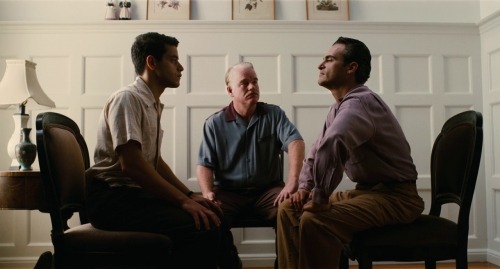
Next, Peggy reads Freddie sexually explicit passages from a book in a Demme-like closeup and Freddie is not supposed to react or say anything. Dodd excludes Freddie from eating lunch with the group and makes him stay inside the house continuing the exercises where he continually has to walk back and forth and feel the wood wall and window over and over again. Freddie is at a point now where he names the wall and window random things like “moss”, “rocks” and “barbed wire” as he touches them. My guess is this is an exercise to break down his sense of language....or just break down his mind, because it’s obvious to Dodd he needs to be broken down. I also think Dodd is using this as an experiment for his methods to see what “works”. He watches from outside as Freddie, alone, continues to walk back and forth. The camera pushes in on Dodd and his expression is one of curiosity as well as remorse, yet still barks out orders, “Back again!”.
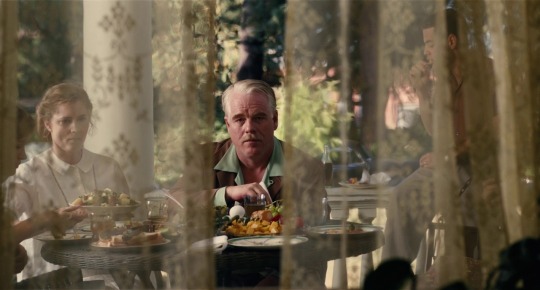
Shortly after, he explains to Freddie that it is a slow, hard process and Freddie looks mentally exhausted. But, eventually, Freddie starts making progress and is becoming stronger. Is it really working? Rami Malek (Clark) is so monotone and annoying here, it really shows Freddie has to be strong to take his insults during the exercises. Peggy even shows compassion for Freddie at one point, one of his biggest naysayers throughout the film. To shift to something technical for a second, I love how the flicker of the film looks in these closeups on Joaquin Phoenix! You can really notice it in the 4K Version. I also remember being very aware it was shot on film while watching the 70mm version at the Egyptian. I know it’s very cool to like film, but I really do authentically enjoy the look of it.
Freddie now does the wall/window exercise with manic energy. There is one moment when Joaquin Phoenix is jumping up and down and almost hits his head on the chandelier’s metal point...and it looks as though Hoffman gets out of character for a sec to block Phoenix’s head that narrowly misses it. Freddie is back feeling the wall like he has hundreds of times, then goes over to the glass again, feels it and deeply says he can touch the neighbor’s plants...the stars...anything he wants... This is not a big moment magnified by a music cue or closeup, but Dodd says enthusiastically “End of application!” Freddie has succeeded in completing the exercise. Perhaps Freddie has now transcended and touched infinity in Dodd’s opinion, realizing he can touch anything he wants (mental freedom), seeing the infinitude in something simple and ordinary like a glass window. Perhaps he has gone through the iterations of the exercises enough to become “clear” (the word “clear” is never used in the film). Dark, foreboding music now comes in during a shared hug between Lancaster and Freddie. In my opinion, the music foretells the bleakness of certainty Freddie is 100% cured.

In the next scene, Peggy announces that Dodd’s new book will be presented in Phoenix, Arizona. After watching a few times, you realize that the work done with Freddie was most likely the catalyst for Dodd finishing the book after administering all the exercises. The film obviously doesn’t come out and say this directly, but we know Freddie has inspired Dodd’s writing, his son earlier revealed that Dodd is just making it up as he goes along and this announcement about a new book comes directly after Freddie “successfully” completes the tests. Also, is it a coincidence the city picked for the new book event is the last name of the actor playing Freddie, as well as the symbolic mythological bird that rises from the ashes after a rebirth?
Dodd and Freddie now are at a remote, desert location I assume is outside of Phoenix. They dig up Dodd’s unpublished work that had been buried. Lancaster carries a gun and looks around to make sure no one’s watching or, maybe, if a magic event might manifest. The score by Johnny Greenwood here is amazing. Again, with the two characters in this scene there is a wonderful naivety regardless of the ridiculousness of digging up this essential manuscript for “The Cause”. They are like two kid soldiers out in the great beyond full of wonder and purpose. And the shirt Dodd is wearing in this scene is hilarious.
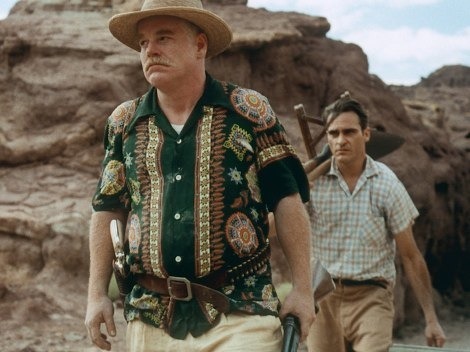
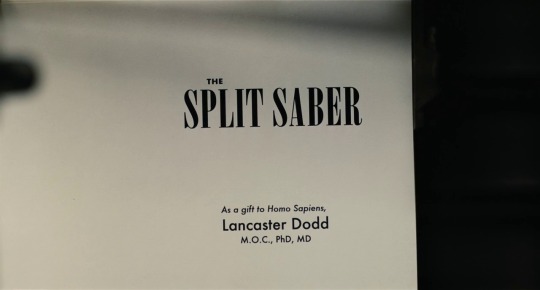
“The Split Saber” is printed on the press. Freddie takes pictures of Dodd, which are funny and sweet. I’ve included a pair of photos below that look to be influenced by photos taken of L. Ron Hubbard.
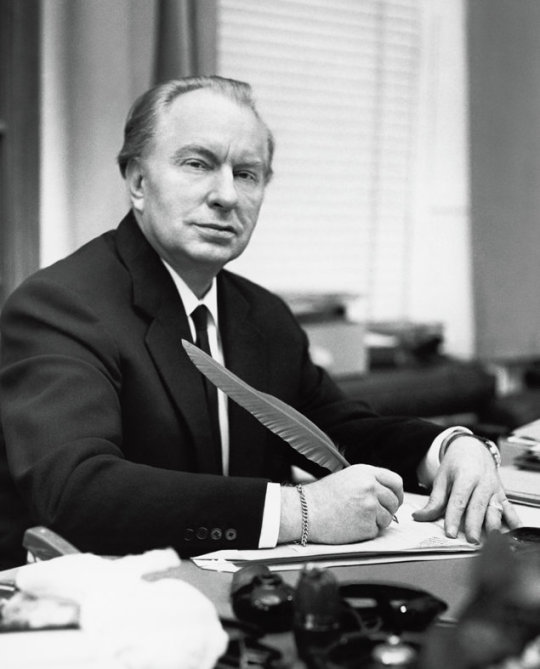
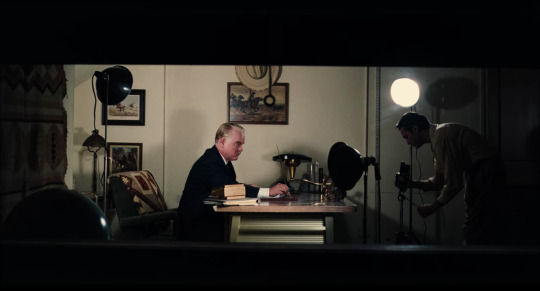

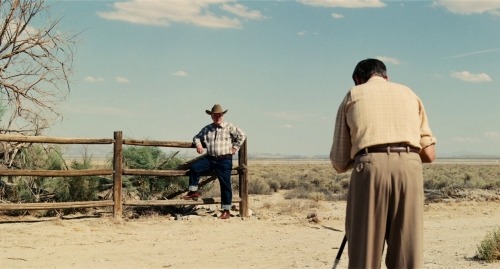
Everyone is gathered at the book event in Phoenix now. Dodd sits in a side room and is visibly nervous. There is a church vibe to the event. The Master (Dodd) comes out on stage to cheers from the crowd. Freddie sits in the middle listening intensely with a yearnful look on his face, perhaps hoping Dodd has a huge secret to reveal. Unfortunately, Dodd just basically says some of the same stuff he’s said before and Freddie looks let down. Anderson’s closeups on Phoenix in shallow depth of field continue to be revealing and look magnificent! Freddie paces afterwards behind the stage, looking lost, angry and confused. As you look at him, his pants, shirt and shoes are way too big. Maybe because he had to borrow some decent clothes from Dodd. Phoenix walks with Freddie’s unusual gait like a wounded clown. A friend of The Cause from New York, Bill, who we’ve seen before, reveals to Freddie he thinks the book stinks. Freddie asks Bill to go outside with him and just completely snaps and slaps Bill hard multiple times. There is something comical about this. It’s as if Freddie’s been holding this monster at bay and then just releases it all on poor ole Bill. Freddie has a history of lashing out at naysayers of The Cause but I don’t believe this is the main reason for the attack. I think Freddie now knows he is not “cured” or “clear” like previously thought. I think the lack of answers he felt he was going to get from Dodd’s speech and book pushed him to this, knowing deep down Dodd doesn’t have all the answers like he expected. In the following scene, Laura Dern’s character sweetly approaches Dodd sitting alone on stage after the event. She confronts him about something he has changed in the book regarding the processing and seems very confused. Dodd has a comically loud, insecure outburst displaying his lack of patience and also his unacceptance of criticism. Obviously, Freddie and Lancaster both simultaneously react harshly when The Cause is questioned despite the contrasting prior exercises practicing non-reactivity.
Freddie Runs
Now Freddie, Lancaster, Clark and Elizabeth drive a car and a motorcycle out to a deserted lake bed. On a personal note, I shot my latest short film’s biggest scene in a lake bed very similar...so similar I had to look it up online to see if it was the same one. It was not. Anyway, I remember in Roger Ebert’s review he seemed to be perplexed by this scene and what it represented. I just think Dodd decided it would be a good idea to get away and blow off some steam with a motorcycle after the stressful book event. I personally really like this scene. It’s funny, it’s visually interesting and there is a danger to it. Dodd explains the game is to pick a point and then drive the motorcycle to that point. Dodd does this first. Now it’s Freddie’s turn. Freddie takes off and speeds away. Dodd does this funny thing in closeup where he puts his hand up to block the sun, watching Freddie ride, then goes to say something, stops himself, then eventually ends up yelling, “Freddie!!” It’s something so small but Hoffman makes it so interesting and humorous and it’s hard to explain why. In my Short Film, I start my scene at this similar location with my hand up looking in the distance, as a nod to this scene with Hoffman (3rd photo).
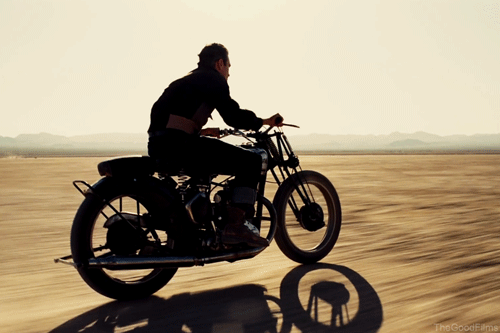
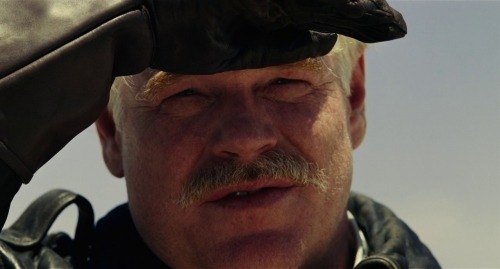

Freddie is long gone with the bike. Dodd’s best friend has left him. “No Other Love” by Joe Stafford comes in perfectly here. It’s such a melancholy end to the scene and I just feel the song compliments it so eloquently. It’s my favorite song of the film because of this and is in the trailer. Freddie goes to the house of the girl he loved before going to the war. He finds out Dorris is married now with kids and lives in Alabama. He finds this out by talking to Dorris’ mother. Freddie missed his shot. The scene is slightly comical due to the dichotomy between the sweet, mannerly mother and Freddie’s pressing roughness and gnarled face. It’s something I always notice and enjoy watching. We are transported now to Freddie asleep alone (most likely drunk) in a movie theater. You can hear Casper the Friendly Ghost in the background and see the flicker of the big screen on the sleeping Freddie and the empty seats around him. There has to be a reason for the choice of Casper the Ghost, but I have no interesting theory why. A theater concierge brings a phone to Freddie after waking him up. It’s Dodd. Either this is a supernatural moment in the film in which Dodd just happens to know where Freddie is (because they’re “tied”) or Freddie is being followed Scientology-style. Freddie nor us know how Dodd knew he was there. This made me think of an interview (somewhere) with PTA saying sometimes details in a film don’t have to make sense or have a definite answer. Dodd asks Freddie to come to England where he currently has a school. He says he misses Freddie and says he can cure him. My guess is he’s had someone find and follow Freddie...unless the Casper the Ghost reference somehow hints at the supernatural spiritual “tie” Dodd mentions between him and Freddie and Dodd just “knew” he was there...but my theory connecting this may be too far of a stretch.
On a Slow Boat to China...
Freddie is once again traveling on a boat, which has become a motif... Freddie adrift. We see the recognizable deep aqua water paired perfectly with Greenwood’s score. The music, once again, adds so much here, producing a sense of longing and beauty.

Freddie arrives at the school looking haggard and gaunt. Jesse Plemons’ character (Dodd’s son) greets him with a wry smile of familiarity which soon turns to concern after examining Freddie’s appearance. They walk down the burgeoning school hallway to Dodd.
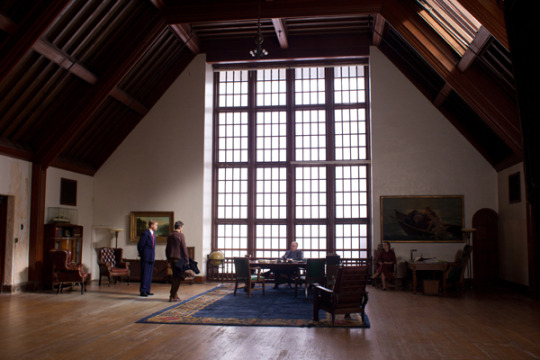
Freddie enters with wild eyes to Dodd’s grand office. Peggy sits off to the side and Dodd at his desk. Freddie hands Dodd some Kool cigarettes and they hug. Peggy immediately asks Freddie if he’s drunk, says he looks sick and says he’s not interested in getting better. She storms out. The two men share a smile after she leaves, but Dodd’s hands are tied. It’s worth mentioning Amy Adams (as Peggy) was also nominated for an Oscar for her role and plays a sort of antagonist to Freddie. Dodd’s book was not well received by close peers and perhaps this was due to Freddie’s influence and she saw this, maybe encouraging Dodd to cut ties because of Freddie’s negative influence and lack of dedication to The Cause. You can see here Dodd loves Freddie very much. This is scene is so good! There is a lot of heart and power here in these closeups. Dodd loves Freddie’s freedom. Freddie depends on Dodd for structure and meaning and a place to stay. Dodd then says my favorite lines of the film, “For if you figure a way to live without serving a master...any master...then let the rest of us know, will you?” With the risk of over-explaining, I’ll dive in with my thoughts... Dodd seems to think everyone has a Master...an obligation, a social role and something transcending mammalian daily life to quench existential and spiritual need. But does Freddie have a Master? I think Dodd thinks if anyone might know how to live without one then it would be Freddie. Would this make Freddie “The Master” and not Dodd? Who is the prophet? Dodd calls him “a man navigating the seas, going wherever he pleases, paying no rent” and you realize Freddie’s steadfast gaze reveals a mastery of something...especially according to Dodd. The culmination here of bringing to consciousness the pair of opposites in character form proves to be the thesis of the film. This is not a film with a traditional story (perhaps that Ebert hoped to understand clearly) but a special situation between two men and how they fit together like puzzle pieces...two sides of the same coin...to the point where one might think it’s possible they did in fact know each another in a past life. Dodd mentions this upon meeting Freddie for the first time and Freddie agrees there is a mutual recognition. Two inverses folding into one another creating something whole, for better or worse. Dodd goes on to explain that he finally figured out where they met in a previous lifetime and says if they meet again in the next life they will be sworn enemies. Again, there is a lovely naivete here...and said with such earnestness. And as mentioned before, it is easy to like Dodd because you believe that he believes what he says, even though we, the audience, are speculative. Again, this is not a film about trying to figure out the legitimacy of a cult but about two men trying to navigate the world the best they can. Dodd goes into great detail about their past life association. In appearance, Dodd is so regal, reserved and groomed...so certain! Freddie is mangled, gaunt and lost. Dodd now begins to sing, which is funny and heart-breaking at the same time. It’s as if this is the best way he knows to express how he feels in the moment. I remember the first time I watched this film in the Laemlle Theatre and there were a few laughs here. I also remember watching this part when I was staying with my Dad and Stepmom one Christmas on HBO. I just flipped through the channels and saw this scene and stopped to watch. My Dad had never seen the film but watched this part with me and also chuckled a bit...not in a “that’s ridiculous” way, but in a concentrated way due to the intensity of Hoffman’s performance here. As the scene carries on, I again begin to wonder if these two really did meet in a previous life. Or maybe it’s just so powerful because they both BELIEVE this past life was real, believing in a pre-destined reason for their association in this lifetime.
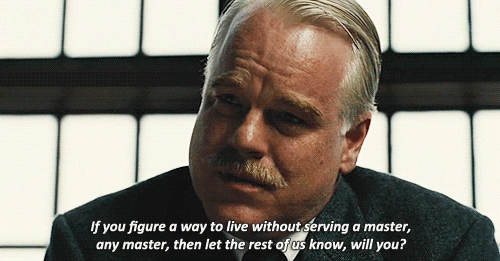
Freddie has now left Dodd. He is out of the office walking alone in a row of trees leaving the school. He goes to a bar, meets an English woman and they go to a room and have sex. Both are fully naked in a very human way lit in natural light. Two hominids in an animalistic act following the parting of Dodd who rejects the animal side for the fully divine. He playfully tells the woman he has to ask her some questions and she can’t blink. The processing scene is obviously still with Freddie and obviously PTA is aware of the power that scene held to call it back. She plays along for a little bit but laughs quickly and breaks. Now waltz music plays, circling back to Freddie on the beach where he was at at the beginning of the film, laying next to the sand woman in oedipal longing. Did he dream all of this?? I have watched the film around 10 times and have never thought about this as much as I have this time around. Of course, it’s ambiguous, but it could very well be true. And he did mention to Dodd in the England office he had a dream, but never got a chance to explain what the dream was. Dodd then went on to talk about their past life association. Anyway...the interpretation that I had come to previously was that Freddie has gone on this journey, but has ended right back where he started, meaning no amount of processing or methods to change his behavior can change his determinism. He is what he is. In fear of repeating this too much (which is never overtly stated in the film) humans cannot escape the fact that they are also of the animal kingdom. I believe the first shot of Freddie in the film mimicing the monkey introduces this idea. And Anderson doesn’t seem to care if the audience gets this first, coded, specific detail, but I believe there are enough clues throughout the film to make the animal comparisons to come to the same interpretation, as I’ve pointed out above multiple times to really bring my point home. Also, Freddie cannot escape how he may have suffered in the war, nor the trauma of his childhood, nor the loss of his sweetheart, Dorris, as he lays next to the breasts of the manufactured woman made of earth as the tide rolls in and out. This is still with him in his memories, shaping his present, whether he deals with it or not. And, more broadly speaking, perhaps all of this striving us humans engage in for self-mastery, and the constant modifications to ourselves to reach some pinnacle of “perfection”, we have built in our own minds is futile. We just go in this big circle, this journey and we end up right where we started. Are we “better”? Are we different? Are we “cured”? Maybe. Maybe not.

To conclude, I’d like to mention that I’ve discovered pre-determination has loomed large in all three films I’ve written about on this page. I’m not sure if it’s me or the films, but it has been the big picture idea I’ve come to on all three. It also makes me think how cinema itself is made possible, by showing and shaping a world, often overtaking the individual characters’ will. I believe this tells us something vital about our reality...cinema expressing transcendent ideas that can swallow up egoic identification, which is why films like this stick with you, pointing to something larger at play within the individual rather than solely the idea we have of ourselves.
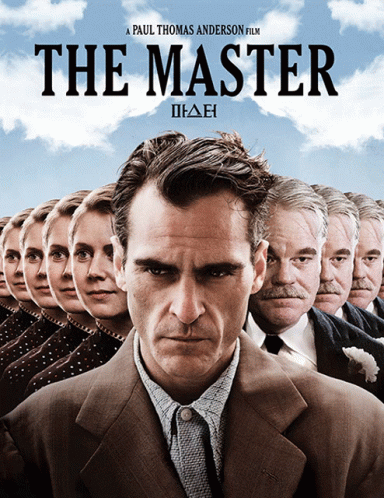
#the master#paul thomas anderson#phillip seymour hoffman#joaquin phoenix#70mm#film analysis#film essay#favorite film#cinema#citizen aycock
0 notes
Text
Climate change metaphors: Crimes, detectives and fingerprints
For quite a few years I have written about metaphors in climate change, such as the metaphors of the greenhouse and the footprint. There is one metaphor I overlooked, and that is the one of the ‘fingerprint’. While the carbon footprint metaphor was used in order to get people to act on climate change, making them aware of how much greenhouse gases they emit and to take responsibility for their emissions, the fingerprint metaphor seems to have been used to talk about the evidence that is accumulating for the fact that greenhouse gases are ‘responsible’ for anthropogenic climate change in the first place.
I was reminded of this when seeing two recent climate change opinion pieces discussed on twitter. One was by Gavin Schmidt, entitled “How scientists cracked the climate change case”, published in the New York Times on 24 October. The article has a wonderful fingerprints illustration/animation, nicely visualising the fingerprint metaphor. The other article was by Andrew Dressler and Daniel Cohan, entitled “We’re scientists. We know the climate’s changing. And we know why”, for the Houston Chronicle published on 22 October. Both articles use the metaphor of the ‘fingerprint’ and of climate scientists as detectives.
This set my metaphor detective whiskers twitching and I rummaged around a bit on both Scopus, for scientific articles on climate change or global warming using the fingerprint metaphor and on Nexis, for media articles doing the same. I’ll first tell you what I found, before coming back to a closer look at the two articles mentioned above.
Tracking the fingerprint metaphor in science and the media
Scientific articles (as recorded in Scopus) seem to have started using the fingerprint metaphor in the early 1990s, that is, around the same time that I found the first fingerprints of the fingerprint metaphor in the media.
In the scientific articles, the word ‘fingerprint’ is sometimes used like an ordinary metaphor at other times like a scientific jargon term, as the following randomly selected headlines show: “Observed and simulated fingerprints of multidecadal climate variability and their contributions to periods of global SST stagnation”, “A globally coherent fingerprint of climate change impacts across natural systems”, “Fingerprints of global warming on wild animals and plants”, “Record temperature streak bears anthropogenic fingerprint“, “Correlation methods in fingerprint detection studies”, etc….
On Nexis, the first media article using the fingerprint metaphor was published in 1989. The journalist used it in a negative way in a comment on the early work by Bill McKibben, his book The Death of Nature. It appeared in Newsweek and was entitled “The Death of an Illusion” (23 October 1989). The author of the review, Geoffrey Cowley, writes: “When dealing with the causes and consequences of the greenhouse effect, McKibben displays a firm grasp of modern planetary science. Yet his larger theme — that human life is different from the rest of life, and that nature ceases to exist once it bears our fingerprints — reflects a willful ignorance of the same science.”
Cowley argues that nature did not end “when cars and factories started raising the concentration of carbon dioxide in the atmosphere. It ended 2 billion years ago, when photosynthesizing bacteria started polluting the planet with oxygen.”
Here ‘fingerprint’ is still used very loosely to talk about the imprint left by humans on nature.
A couple of years later, in 1991, the metaphor is used in its current form in an article published in The New York Times by William K. Stevens, entitled “Global warming: Search for the signs” (29 January). He points out: “[Climate scientists] are struggling to answer a crucial question: how can a greenhouse warming of the climate be recognized and distinguished from natural warming? They are focusing their detective efforts on various subtle changes that a greenhouse warming would be expected to induce. These signs are known collectively as the greenhouse ‘fingerprint.’”
The article lists a number of ‘fingerprints’ which distinguish greenhouse warming from natural fluctuations in the climate system, such as global temperature patterns, sea surface temperatures, water vapor in the atmosphere, changes in seasonality, rainfall patterns and so on.
After that the use of that metaphor climbed steadily and is now quite ubiquitous (searching for ‘climate change’ and ‘fingerprint’ on Google gives you 3,940,000 results).
The metaphor can, of course, still be used in articles critical of climate science and of climate scientists who are doing the detective work, as for example in this article published in The American Spectator entitled “The Great Hoax”, published at the time of ‘climategate’ on 16 December 2009 (a framing that is still very much with us today). It says under the section heading: “Man-Caused Global Warming Proved False”:
“Even the UN’s own climate models project that if man’s greenhouse gas emissions were causing global warming, there would be a particular pattern of temperature distribution in the atmosphere, which scientists call ‘the fingerprint.’ Temperatures in the troposphere portion of the atmosphere above the tropics would increase with altitude, producing a ‘hotspot’ near the top of the troposphere, about 6 miles above the earth’s surface. Above that, in the stratosphere, there would be cooling. But higher quality temperature data from weather balloons and satellites now show just the opposite: no increasing warming with altitude in the tropical troposphere, but rather a slight cooling, with no hotspot, no fingerprint. Game over. QED.”
The flexible use of a ubiquitous metaphor
So, what about the two articles by Schmidt and Dressler/Cohan, how do they use the metaphor of the fingerprint. At this point I need to point out that this metaphor is actually a metaphor cluster using the whole semantic field of detectives following tracks, finding fingerprints, finding suspects, culprits or criminal, solving a crime and so on. In this context, climate scientists are framed as detectives and indicators for anthropogenic climate change as fingerprints left behind by various suspects, etc.
Schmidt starts his article by pointing to the planet as “the biggest crime science”, indeed he points out that the “biggest crime scene on the planet is the planet”. He talks about the drivers of recent climate trends and how to find out about them: “It comes down to the same kind of detective work that typifies a crime scene investigation, only here we are dealing with a case that encompasses the whole world.” The question is how to find the suspects for this planetary crime: “Scientists have no shortage of suspects for the causes of climate change.” He lists some and says: “Each of these events left a unique fingerprint of change on the climate system […]. To track down the culprit of any one specific climate change involves piecing together the contemporaneous fingerprints and tracking them back to the plausible causes.”
He notes that there “some new suspects too”, mainly linked to human activity. The climatic changes brought about can now be studied with “a new array of tools’ developed by climate scientists working “like forensic detectives”. Using these tools it has become clear that “the current warmth is impossible to explain without human contributions. It is on a par with the likelihood that a DNA match at a crime scene is purely coincidental.” He concludes by saying quite categorically: “The forensics have spoken, and we are to blame.”
Now to the Dressler/Cohan article. They try to explain why scientists are so confident in their assessment that human activities are to blame for climate change and say: “To understand why we are so confident, it’s useful to think about climate change as a whodunit. Climate does not change by itself, so scientists are detectives trying to solve the mystery of what has been warming the Earth for the past century.”
And: “the first thing that scientists do is study these mechanisms to see if they could be the culprit.” They go through various non-human mechanisms that could be the culprits, like the sun and points out: “The Sun, however, has an airtight alibi — we have direct measurements of the output of the Sun from satellites, and we observe that the Sun has not gotten any brighter. One suspect down.” What about the earth’s orbit? “Earth’s orbit changes too slowly and is now in a phase that should be slowly cooling temperatures. Another suspect down.” The same goes for volcanoes. “There is an entire list of suspects that scientists have looked at, and they have not identified a single viable one. With one exception — greenhouse gases.” They then describe greenhouse gases as the world’s dumbest criminal:
“Police shows sometimes feature the “world’s dumbest criminal” — who doesn’t wear gloves, leaves fingerprints all over the house, drops his wallet at the crime scene, is caught on videotape exiting the crime scene, brags to his friends that he committed the crime — and when he is finally arrested has evidence of the crime in his pockets.
Carbon dioxide is like the world’s dumbest criminal — it leaves evidence all over the place that it’s guilty. He concludes by saying “In this whodunit, you would have no choice but to arrest carbon dioxide for warming the planet.”
Both Schmidt and Dressler/Cohan use the detective/fingerprint metaphor but, as we have seen, in very different ways! For example Schmidt uses the word ‘fingerprint’ three times, while Dressler/Cohan use it only one time. Schmidt uses the word ‘forensic’ twice, but Dressler/Cohan don’t use it at all. Dressler/Cohan use the words ‘criminal’ and ‘police’, words that are not used by Schmidt, both articles talk about ‘crime’ etc.
Conclusion
The metaphor cluster associated with the word ‘fingerprint’ has a long tradition. It emerged as soon as climate science became a matter of public debate, at the end of the 1980s. It has become ubiquitous and can be used flexibly and creatively. At a time when evidence and expertise are under threat, it’s a useful and handy metaphor for evidence gathering and for following that evidence to the most logical conclusion.
So, of course, I have to end with a quote from Sherlock Holmes: “You will not apply my precept,” he said, shaking his head. “How often have I said to you that when you have eliminated the impossible, whatever remains, however improbable, must be the truth? We know that he did not come through the door, the window, or the chimney. We also know that he could not have been concealed in the room, as there is no concealment possible. When, then, did he come?” Conan Doyle, The Sign of the Four, ch. 6 (1890)
The post Climate change metaphors: Crimes, detectives and fingerprints appeared first on Making Science Public.
via Making Science Public https://ift.tt/2JleyGO
0 notes
Text
Reflective Journal BA1B
Reflective Journal – BA1B Emily Hands During the last 20 weeks I’ve had good experiences and bad ones! In this report I’m going to explore what went well, what didn’t, what my favourite parts were and how I could have improved on certain things.
First off is the film project. Having never experimented with film ever, it was like being thrown in at the deep end for me. Although being excited about trying out something new, I was also very wary about it. I decided to use stop-frame animation for my final film, themed on the Jewish Bodies found in a well near Chapelfield in Norwich city centre. I love history, so researching definitely wasn’t an issue for me. However, I did feel that I got a little carried away with the amount of research I did. I feel as if the research outweighed the amount of practical work that I did. I think it was because I was quite worried about starting a film, because of lack of experience. Having left the film to the very last minute has definitely showed in my final product.
Even though I was still quite proud that I’d finished a minute long animation, I never added sound to it, and whilst presenting my film to my peers, I did feel a little embarrassed, as if it wasn’t good enough. My film was black and white, in line work mainly, as I wanted to see if I could use my typical line work style of work as an animation. I’ve always felt that on this course I really wanted to develop my way of working so I did try this for this project. I think if a little more time and consideration was put into my film, using line would have been more successful that it actually was. But all in all this project gave me a chance to broaden my knowledge in a different form of media, that I’d never tried before. Onto the Publishing project, which has been my most favourite project out of all of them. I decided to do my book on the Lorina Bulwer Tapestry, which I found by chance at Gressenhall Workhouse. What I loved about this project, was that I went in to visit the workhouse looking on just doing the project on workhouse life, and came out with a real interesting life story of someone who experienced life there. They’d also created a huge piece of work that inspired my book and pretty much made my life much easier. Loving history too, finding something history based meant that I was really immersed in the subject, and I think this definitely shows through my blog work. Again I do have a problem with going overboard on research. I feel that the more I get to know the ins and outs surrounding my subject, the better the piece of work I can produce.
I made my book entirely out of fabric, which is something I would never have thought about doing before, as usually I work in pen and ink and use a lot of line. I could have quite easily done this again for this project but I didn’t and I feel like I really stepped out of my comfort zone. By doing this I’ve managed to produce a publication that I’m really proud of. Using cross-stitch as my main ammunition for the book, did make it hard time wise, and I probably didn’t do as much planning and as many mock ups as I would have liked to. Bearing in mind that the project was also only 5 weeks long, I was very, very tight on time a lot of the time. I very often try to avoid certain mediums such as textiles because I tell myself that I can’t work that way. Because I found a subject that was heavily textile based I kind of felt that I had to create a book that also showed this, as it was the whole subject matter. This coincidentally was really good for me, to just try out something out of my comfort zone.
Having forced myself to learn to cross-stitch I found out that it was actually really therapeutic, which helped towards me not giving up on the idea of cross-stitching a whole 16 page book! Finding the artist Lynn Skordal, really helped me on my journey to creating the publication. I was finding it really hard to find artists who were doing similar work to me, and I felt as if I didn’t really have many influences. So when I found her home-made embroidered, textile based book I was really excited! I felt as if I could power on through the book making and also put someone of importance onto my blog. Being an illustration student, it’s been really great to create a small publication for the first time and I really did enjoy every second leading up to the final product of this project.
Project 4 was the collaboration project, and it’s been very interesting to say the least. Firstly I’ve never worked in a group before, so it was all very new to me. But I’m also very glad that I met and got to communicate with the people I did. We definitely had our good and bad moments as a group but overall it was a great experience. I’ve learnt that if you do not communicate with each other in a group, then you won’t get very far, and that you will not get rewarded for producing work that shows a lack of knowledge and communication. For a lot of the weeks, I feel like this is what let our group down from producing a display that really worked. We recycled a lot of our work from previous weeks too, and as well as this being an ok kind of thing, I feel like it probably came across as being lazy, and due to the fact we would leave the idea generating till the last minute or day before we had the tutorial.
Other than this there were also a lot of positives too. Generating ideas became so much easier when you're in a group, as there are always people to give you their opinions or share their own ideas with you too. Everyone works differently and getting to mingle with others and expand your knowledge on work methods was really fun. Our subject was gambling, which I found really exciting as a subject, and as the weeks broke down I was given the subject of horse racing for our stand. Our stand was split into 4 different stations: Horse Racing, Roulette, Card Games and Fruit Machines, which later turned into dice games. This strategy worked out well in the end but there were definitely obstacles on the way. The week before the Kaleidoscope event, our mock-up of our stand was an absolute car crash, as over the Easter holidays we hadn’t really made up our games, so the whole thing was very unorganised. Having learned from this, in the last week before the event, we all worked so hard to create a really successful and interesting display that showed off all the hard work and research that had been put into it.
Overall, collaborating with other people was definitely an experience that I will never forget, it’s also a great way to step out of the box, and produce work that you wouldn’t ‘usually’ produce. Next I’m going to quickly talk about my essays. I wouldn’t say that I struggle to write essays, but I do struggle on picking a topic to write about for 1000 words. I feel as if my publishing report is quite weak, as I got strung up with writing about what the publishing industry was about. Having previously had a tutorial with a tutor and them explaining to me that talking about how self-publishing has revolutionised the way illustrators have worked, really confused me, as later on I was told that this was not what I was supposed to be doing. So, I feel as if my essay is a tie up between that and reflecting on my own work and other practitioners.
In regards to the collaborative report, I really enjoyed researching for this essay, and it actually gave me a broader vision of how collaboration can help artists who usually work by themselves. It can create really exciting outcomes, compared to if you always work by yourself, and you can end up stepping out of the boundaries. I looked up Gilbert and George, who I know are very well known, but I never knew how they came to work together as a duo, and that they actually don’t class themselves as a collaborative pair, but the art industry does, which was interesting.
Overall BA1B has been an interesting unit to say the least, but it’s got me to step out of my little bubble and expand my knowledge in places that I never thought I would. I got to create my first publication, and my first animation, and work as a collaborative group for the first time ever! I’m really glad that I’ve stuck through the 20 weeks, and although being slack sometimes through my journey, it’s been a great one!
0 notes